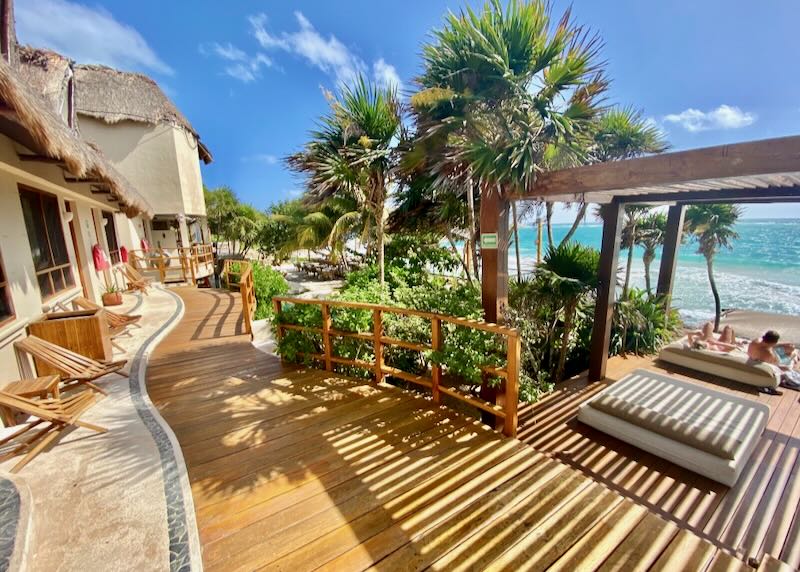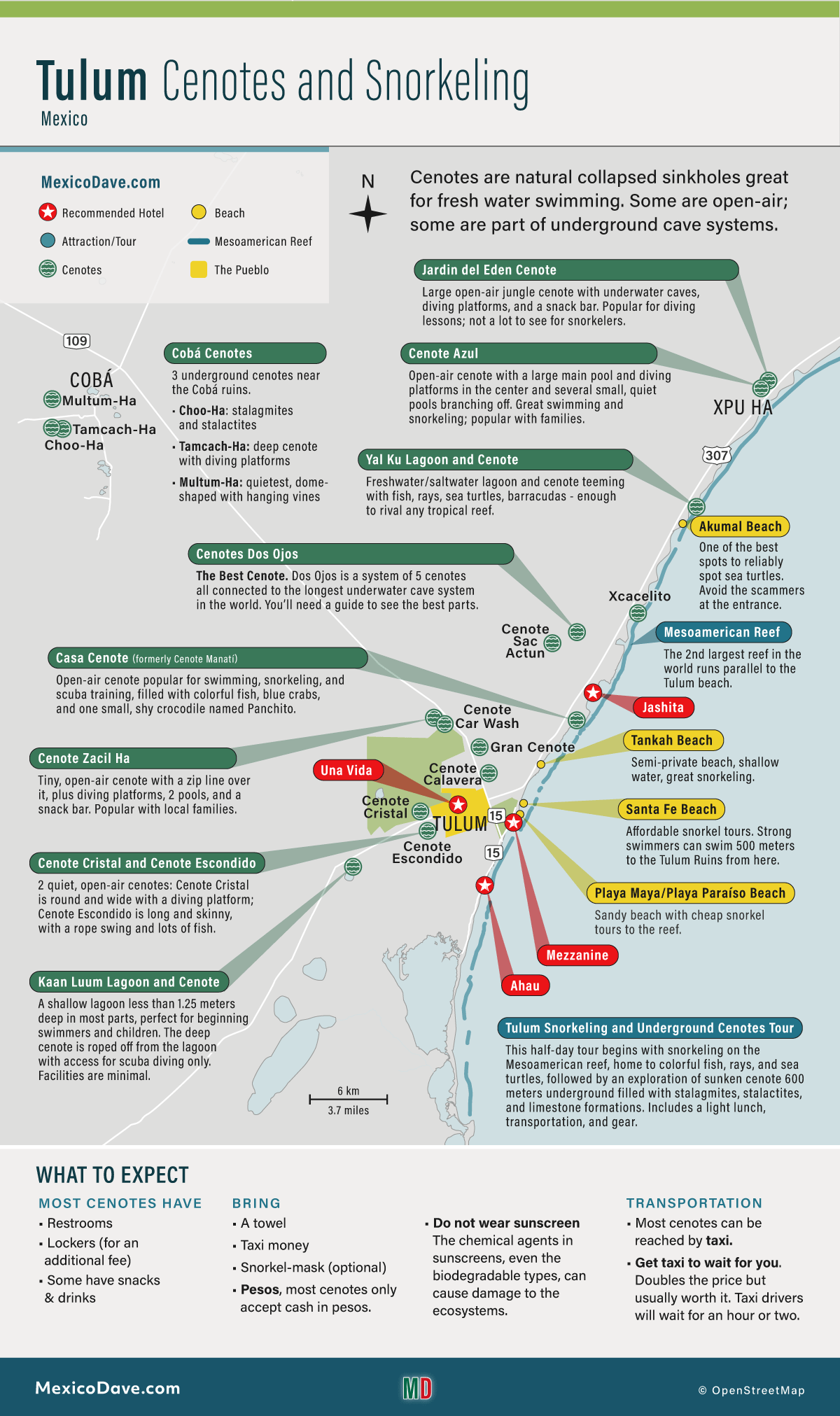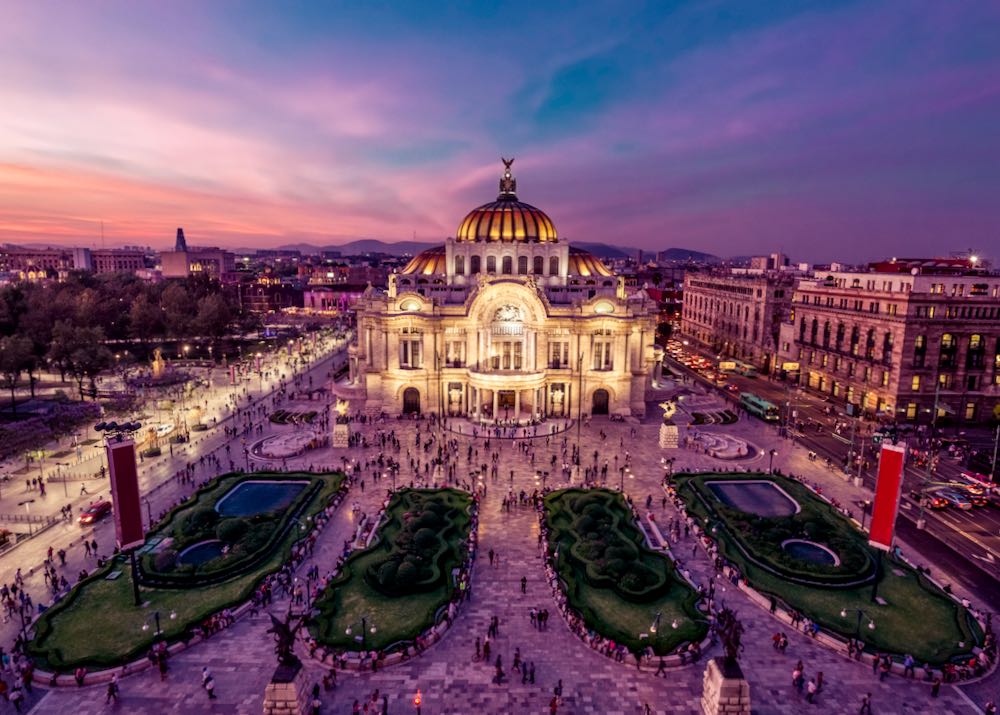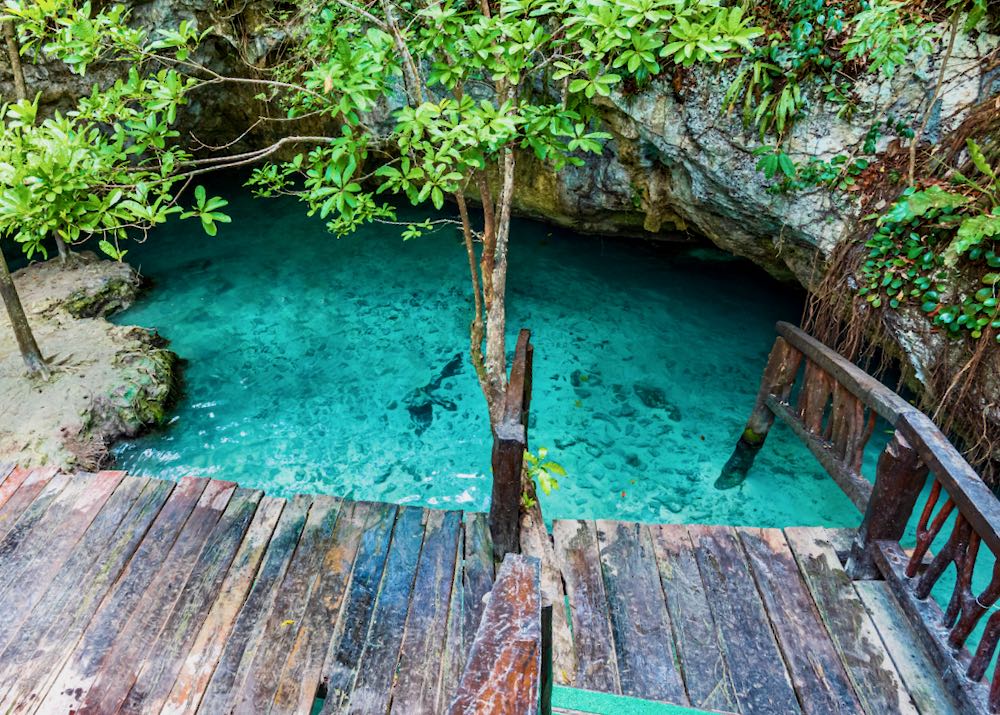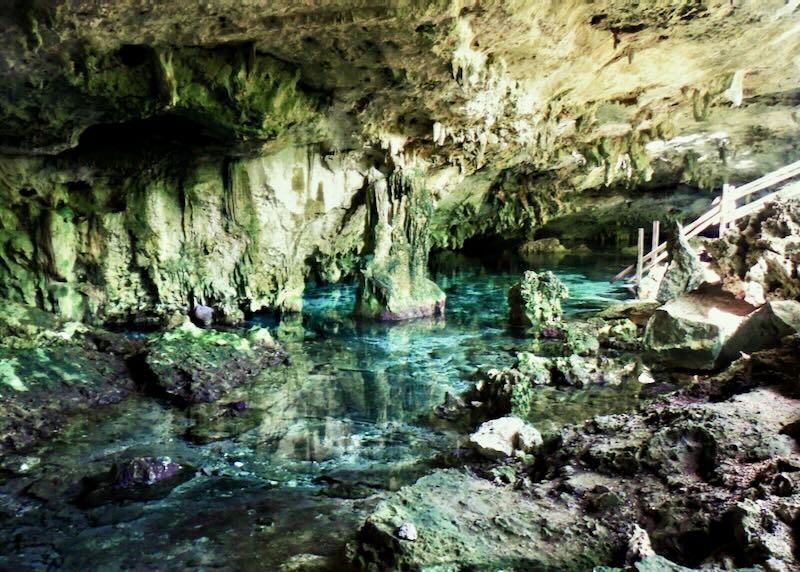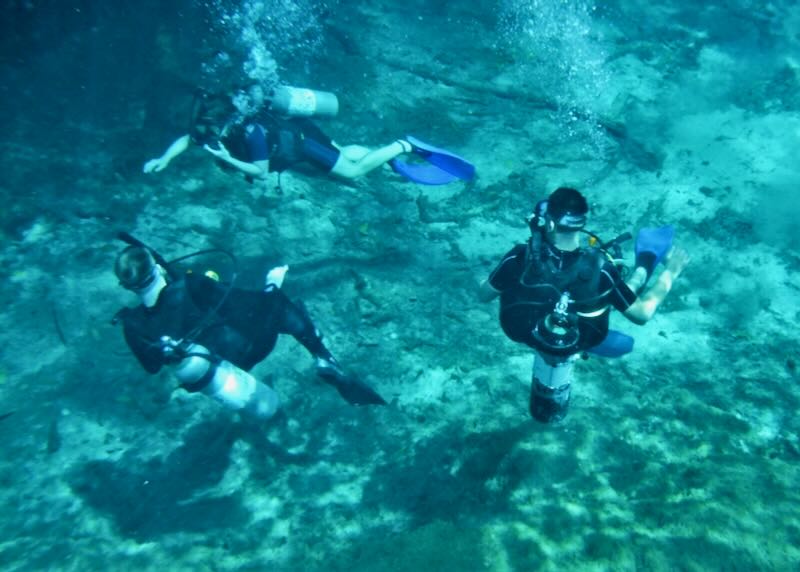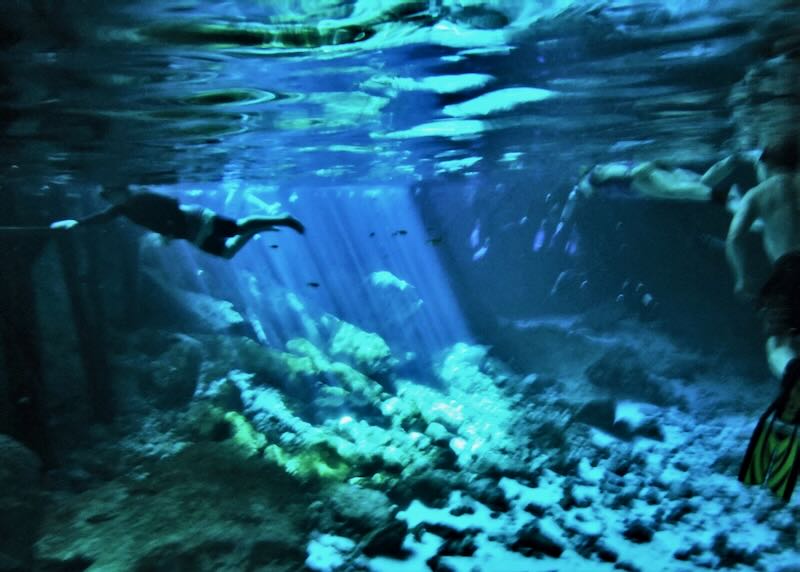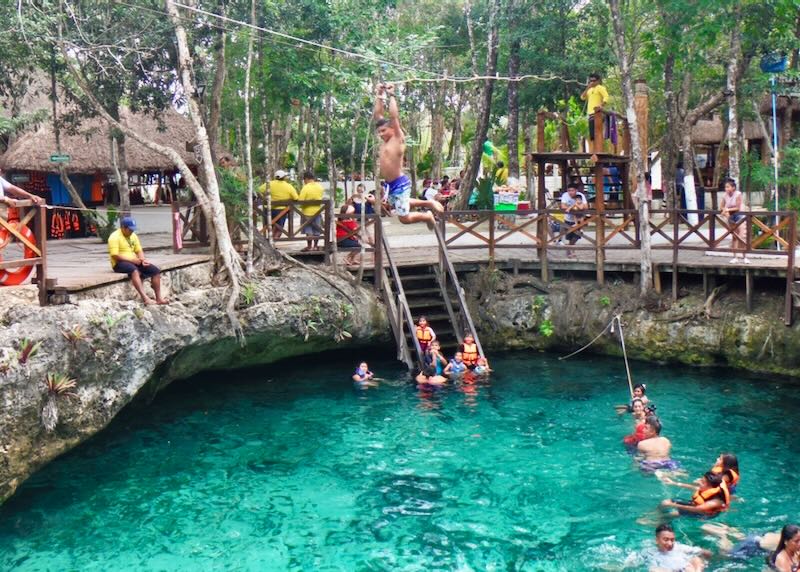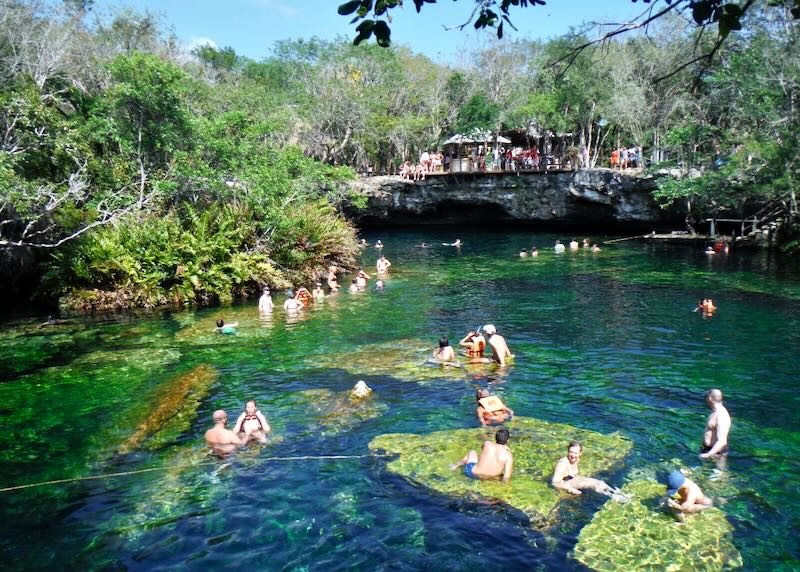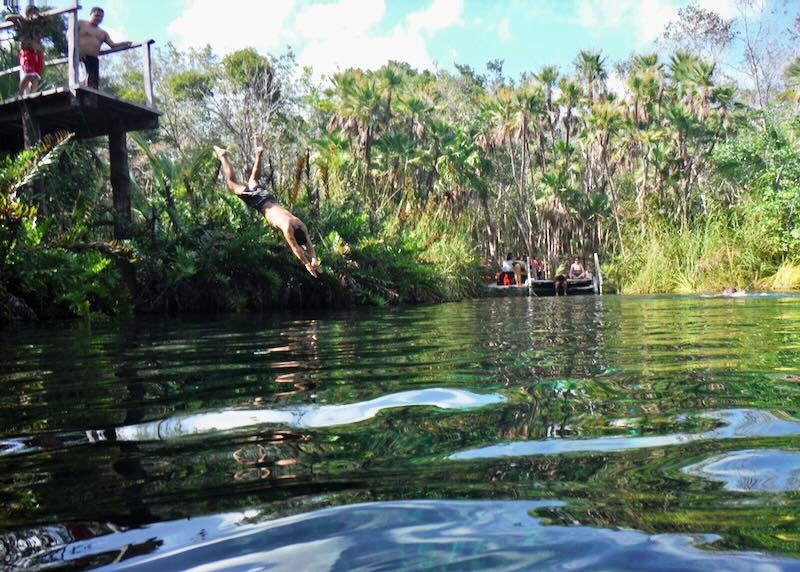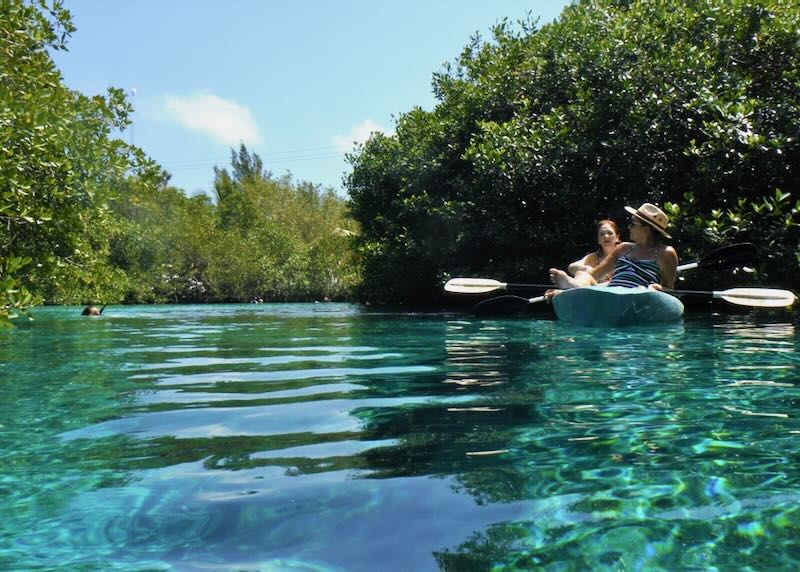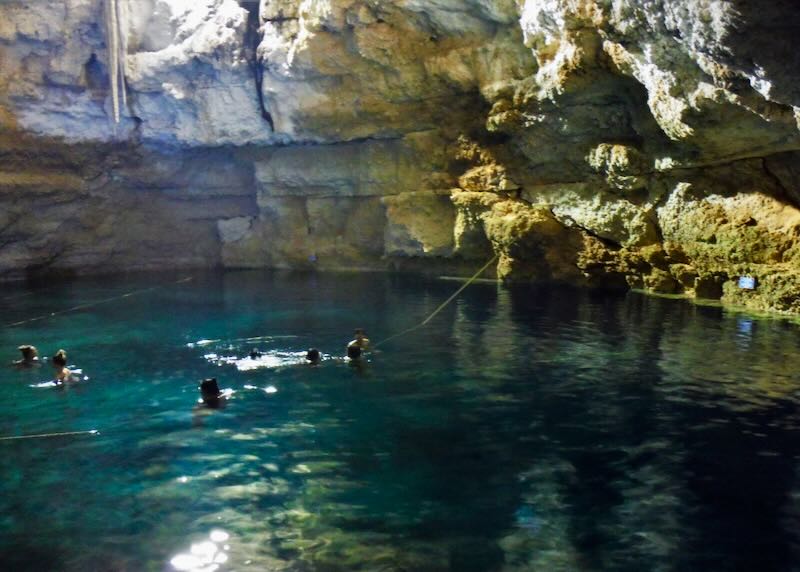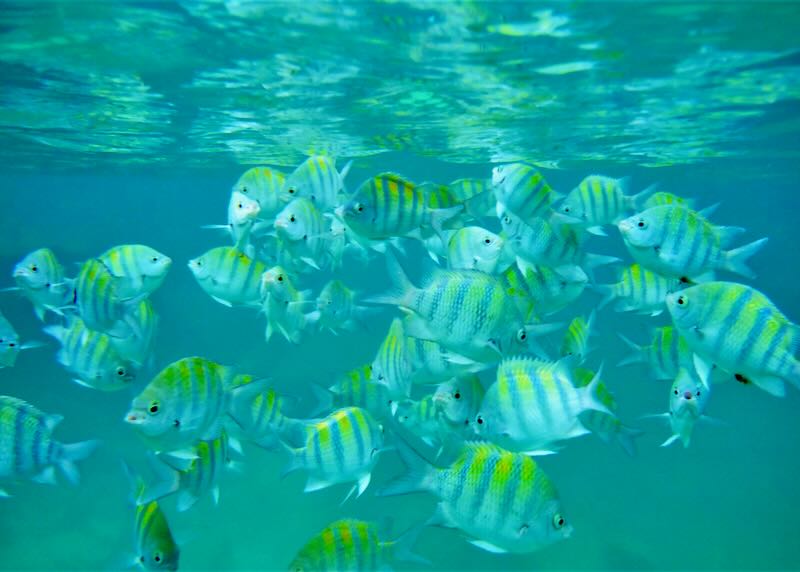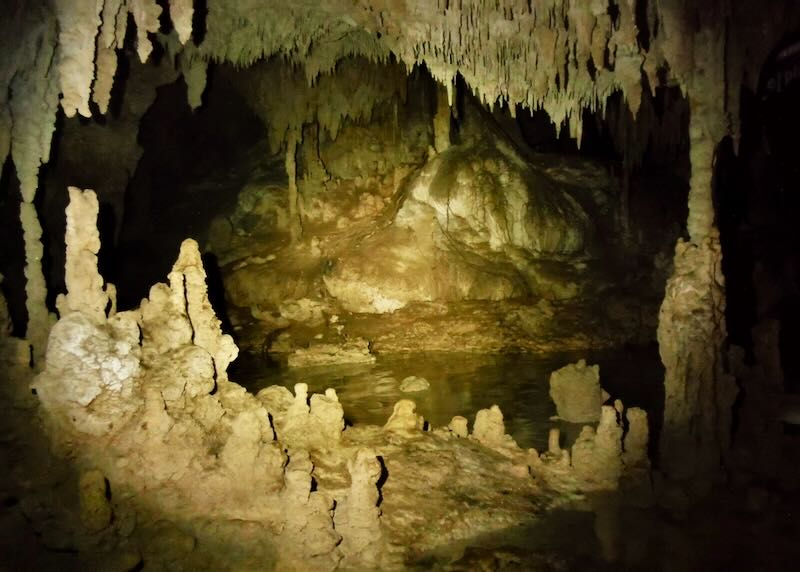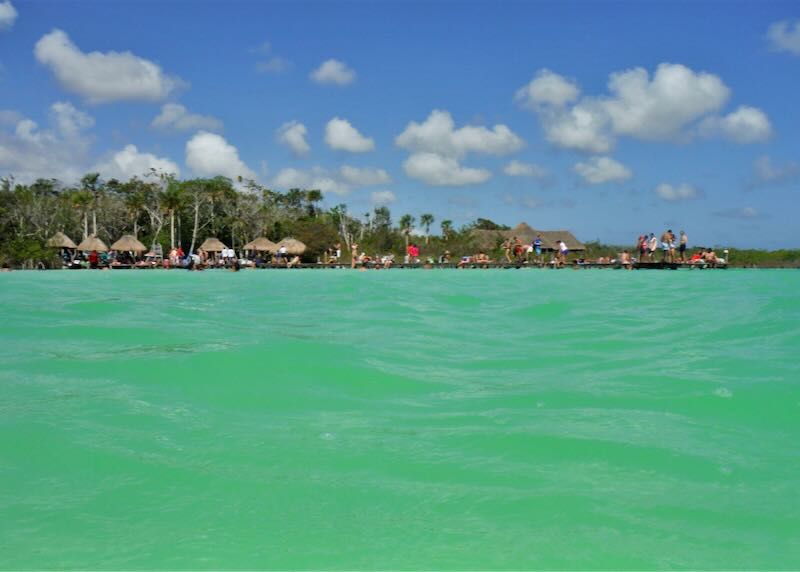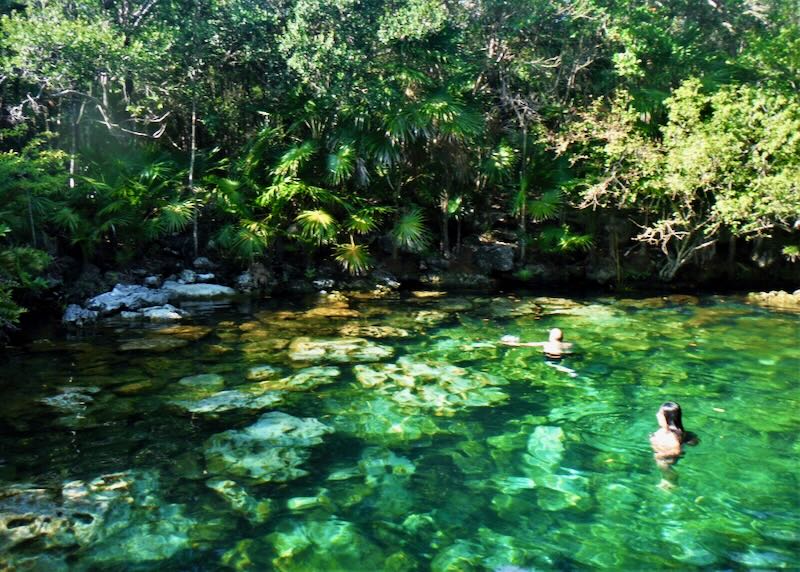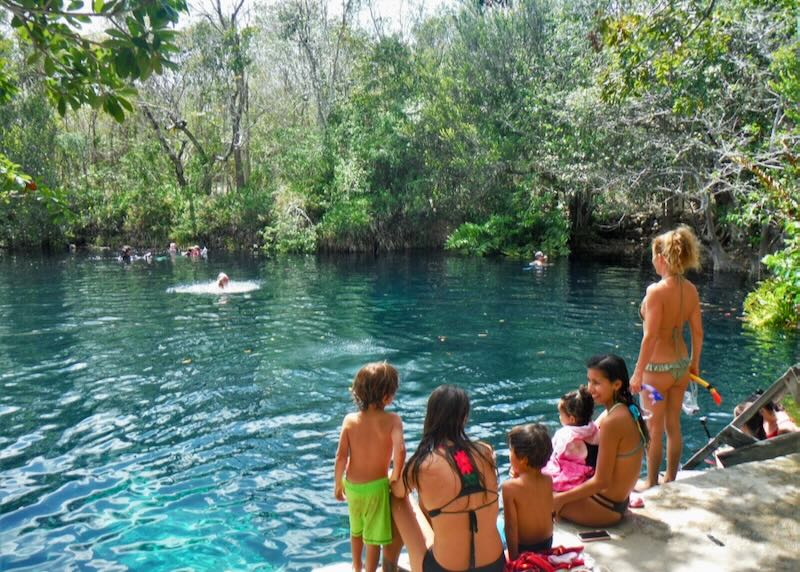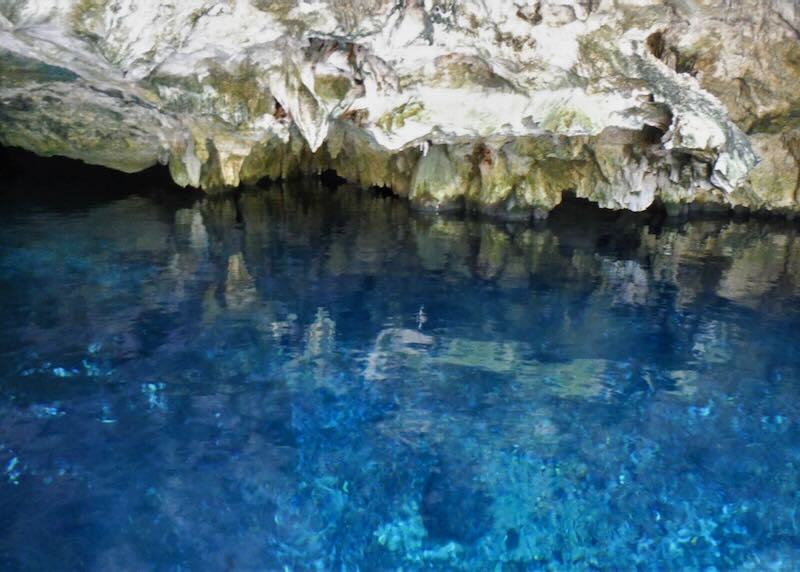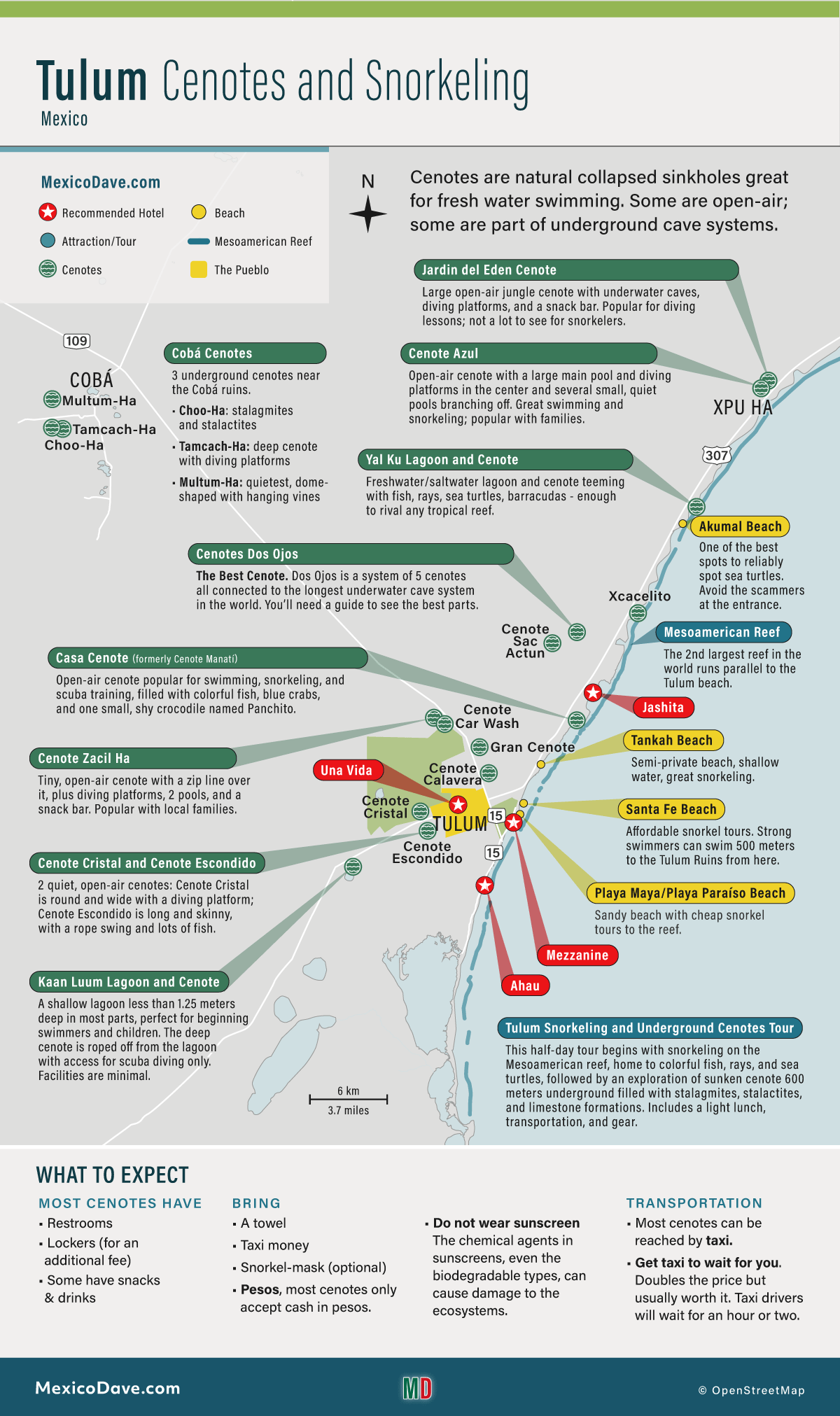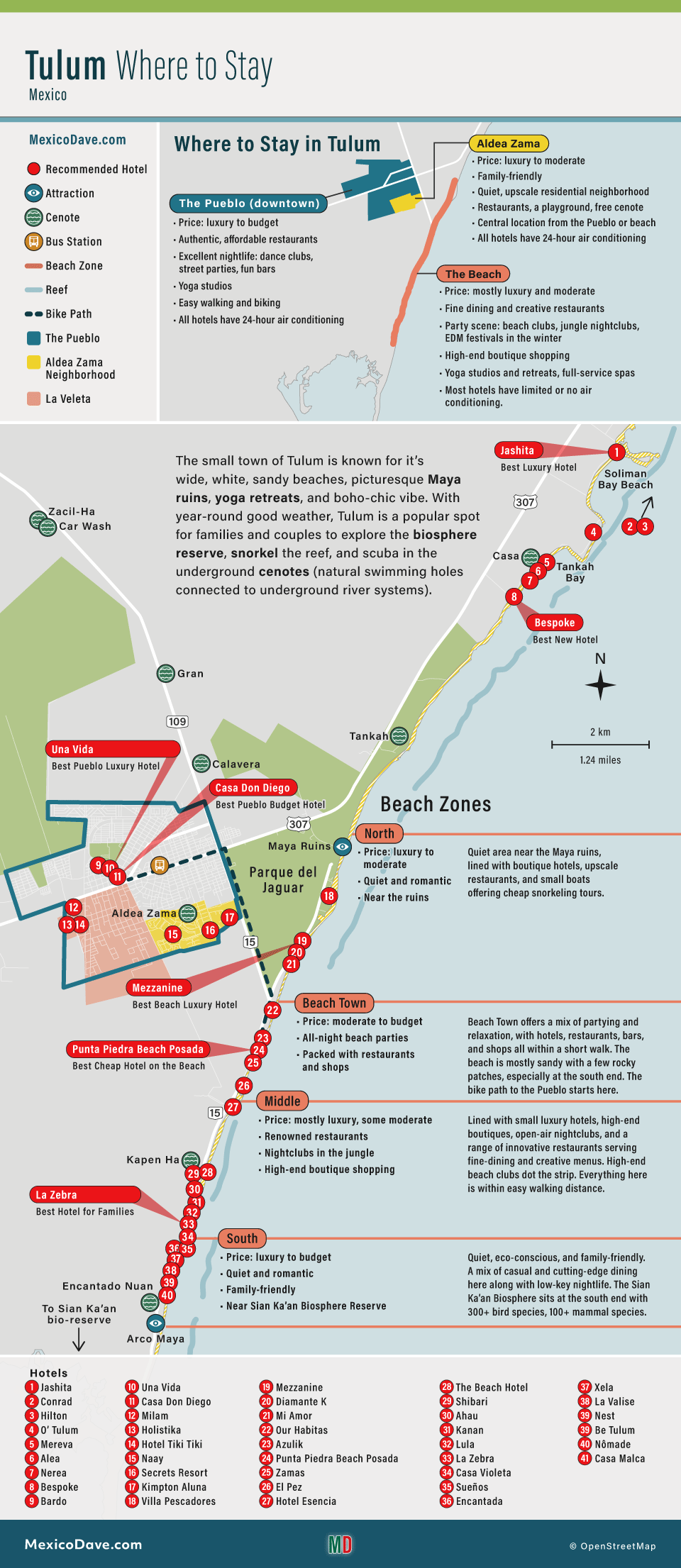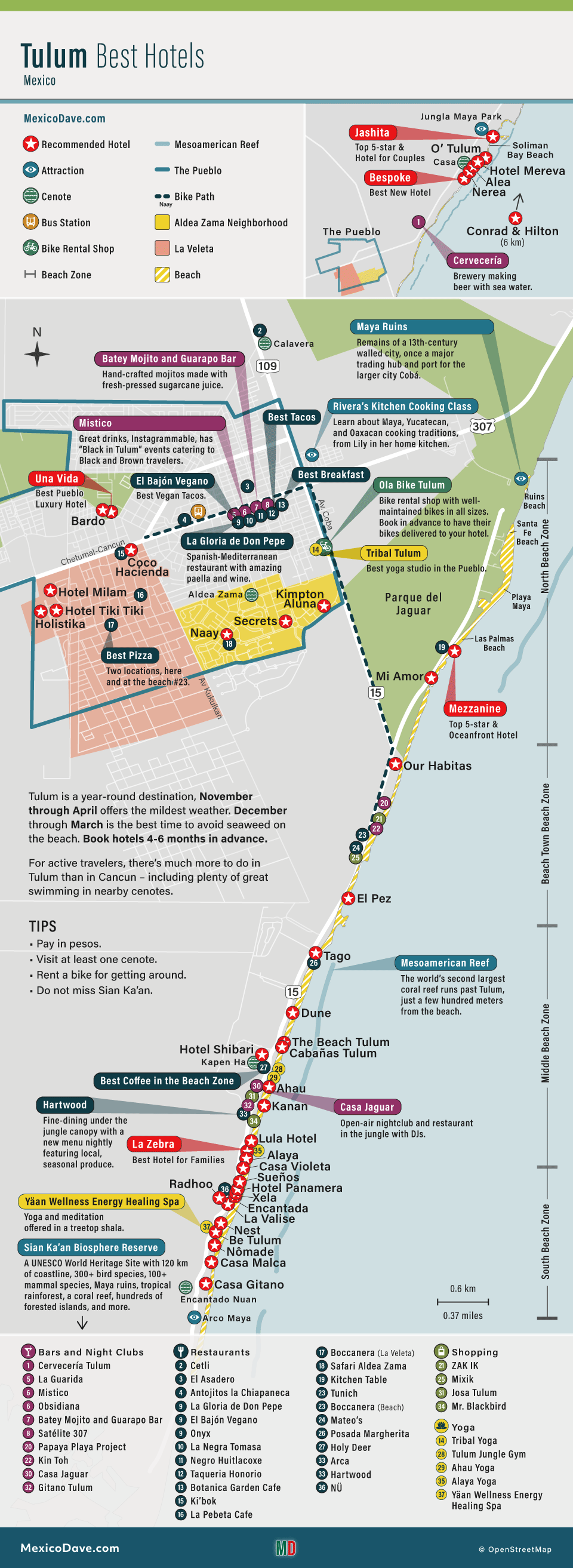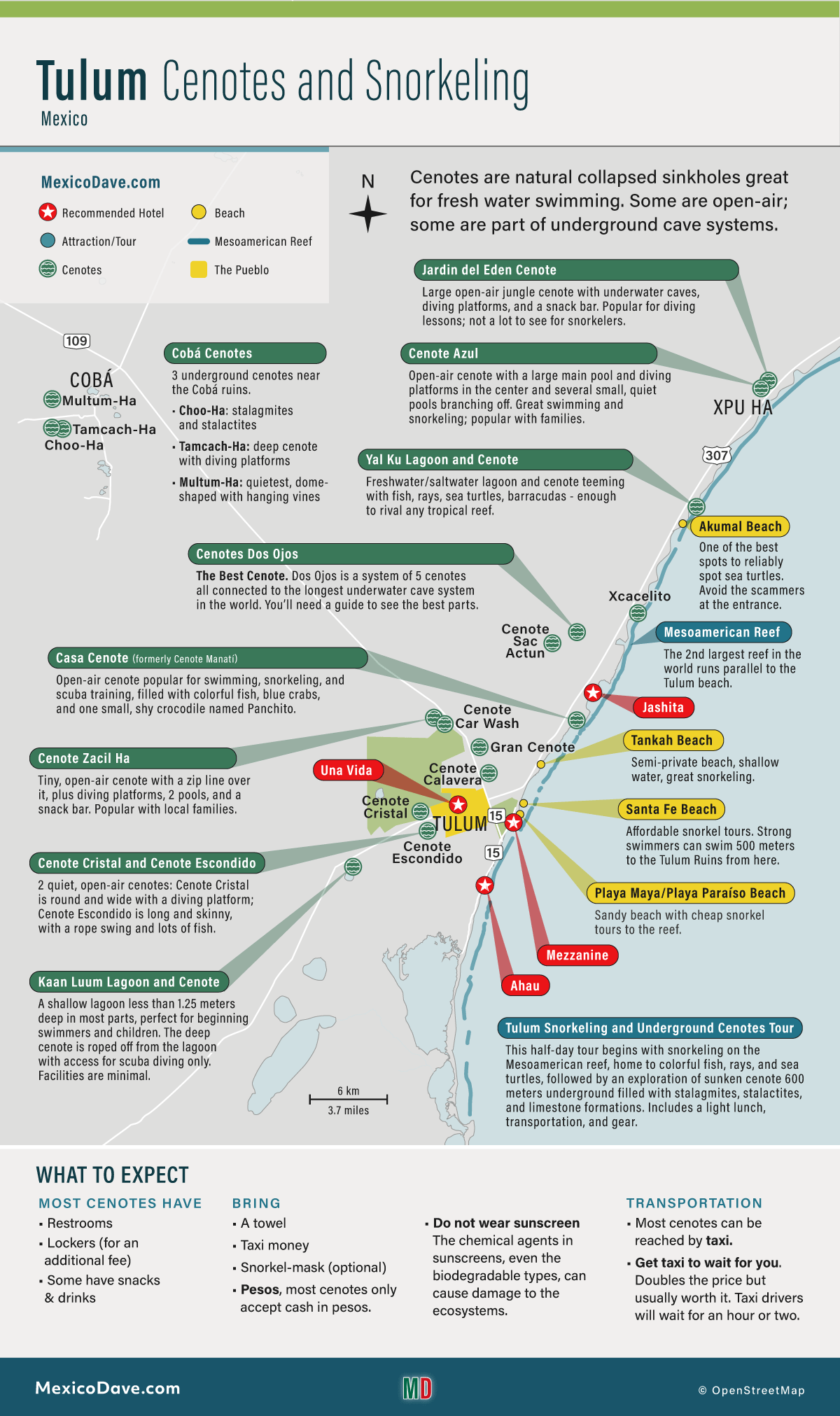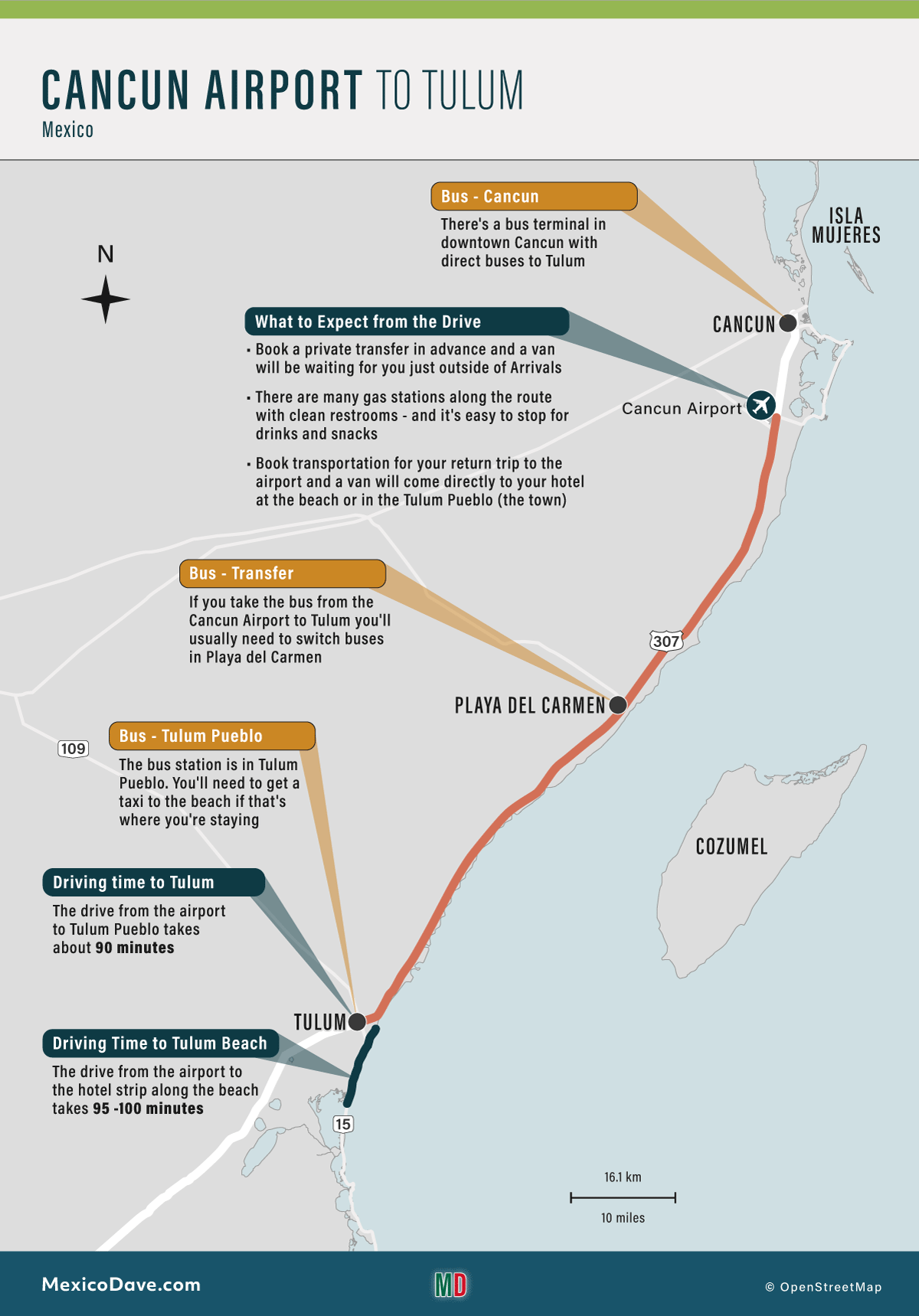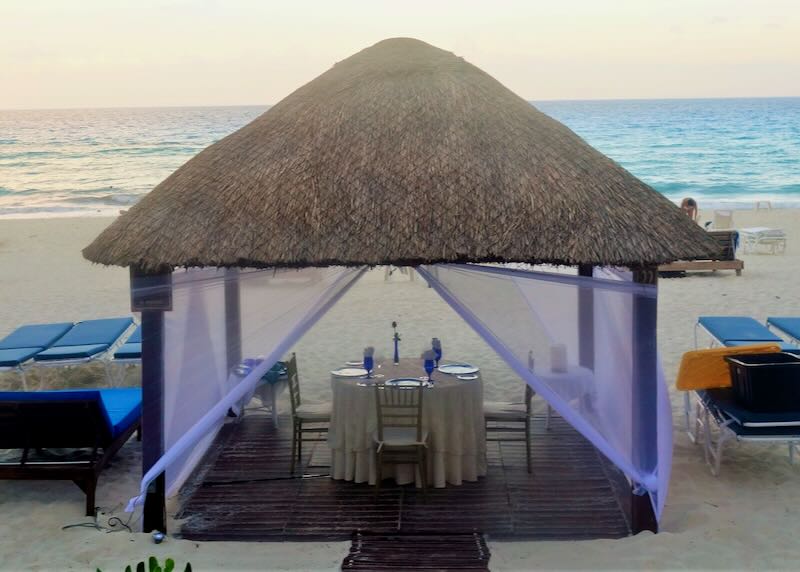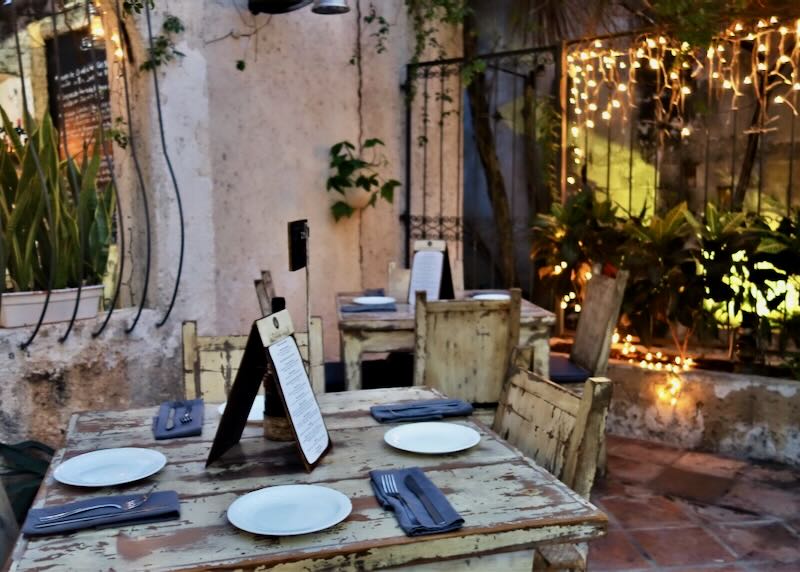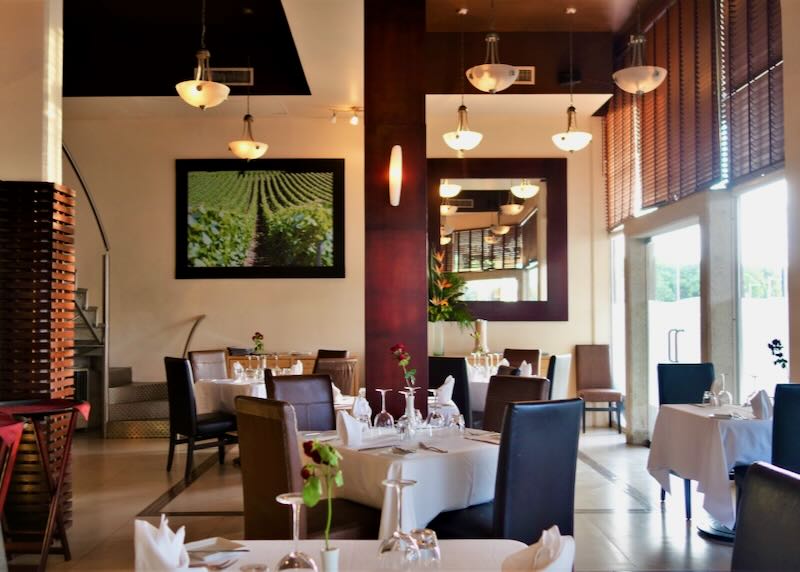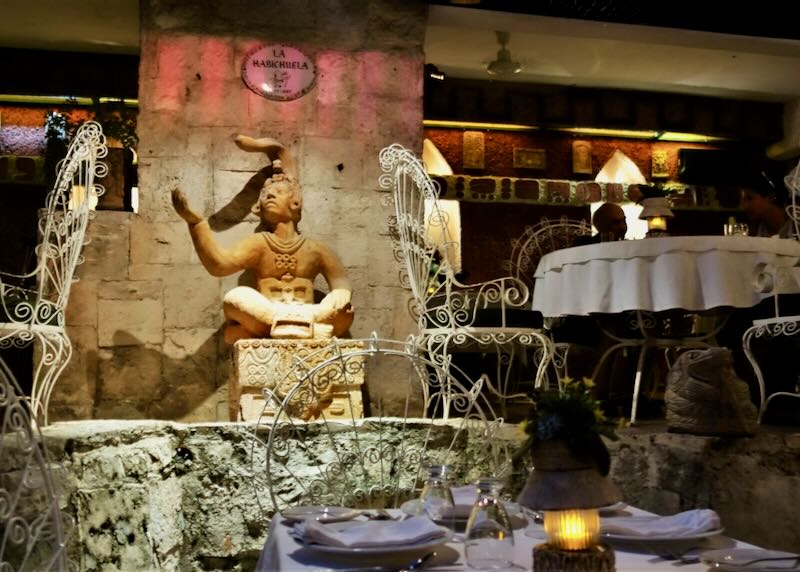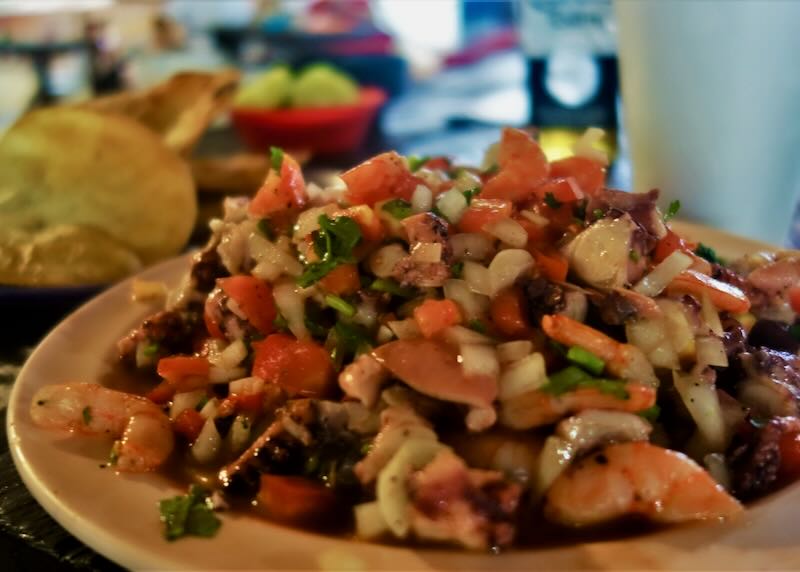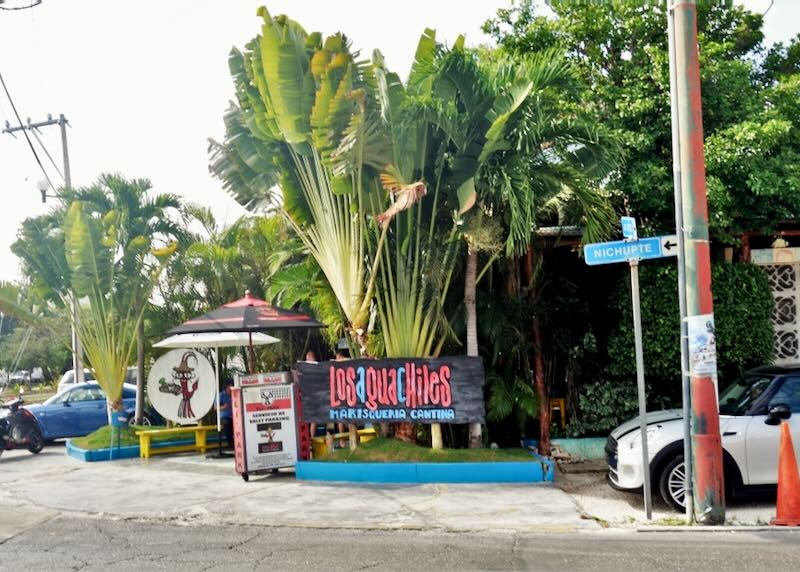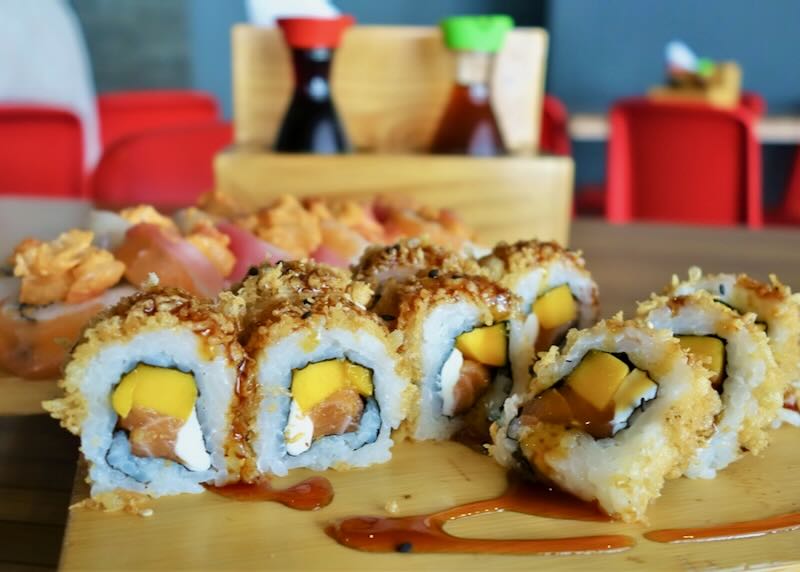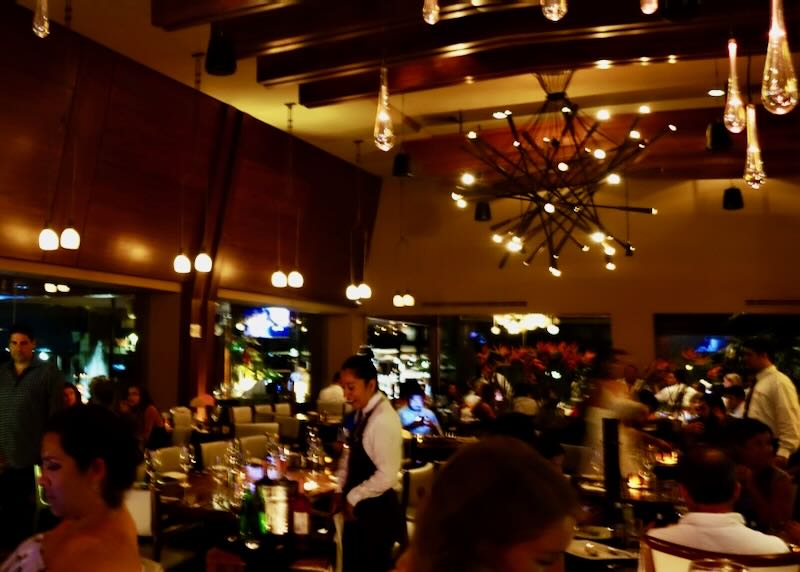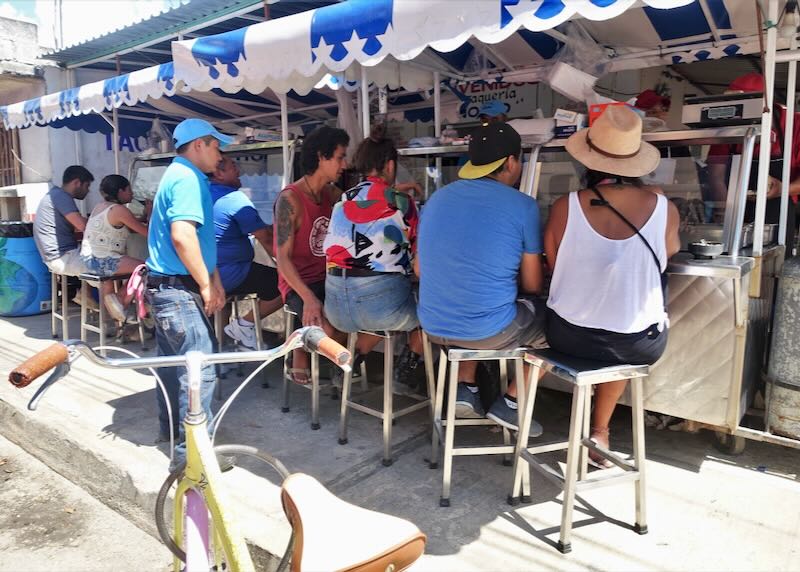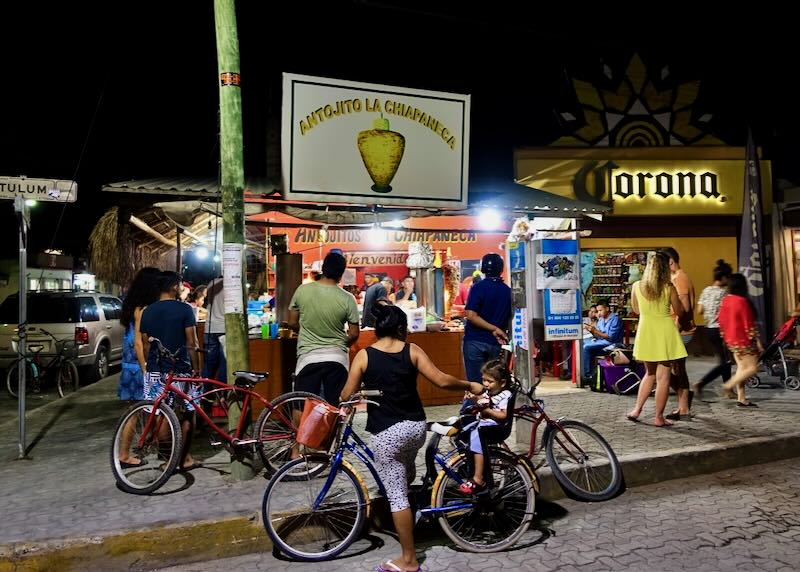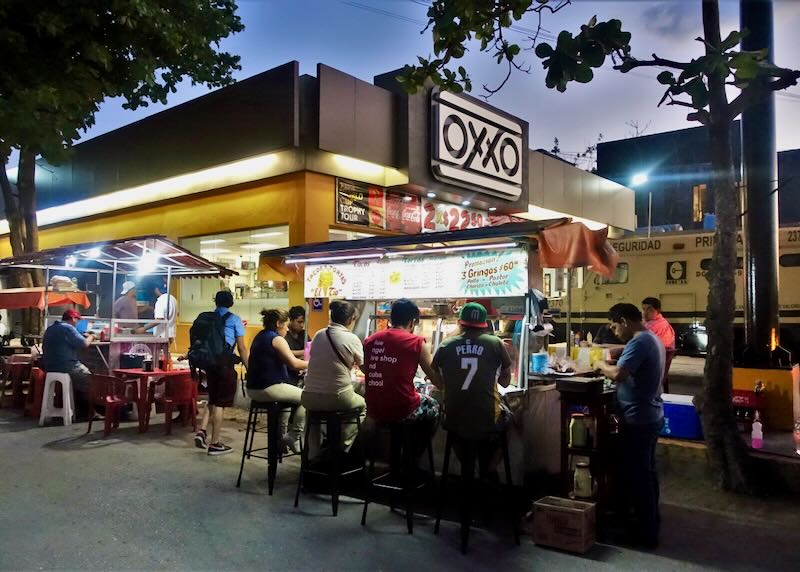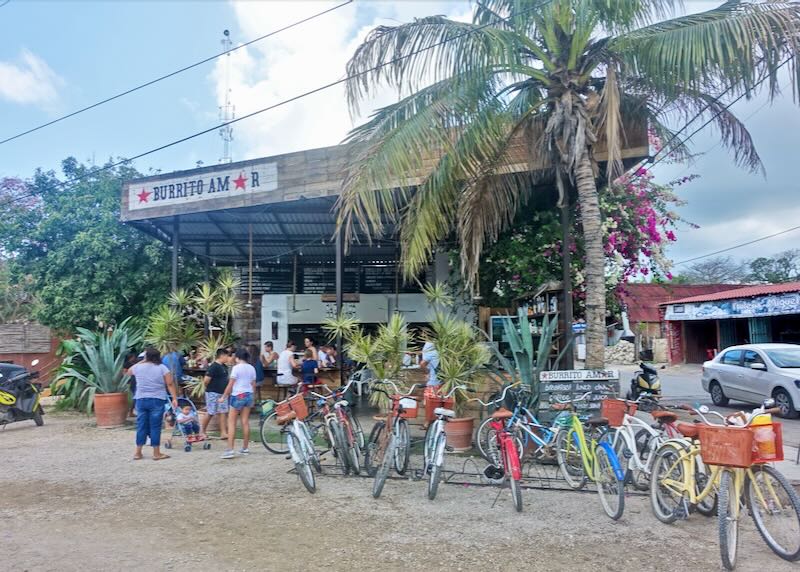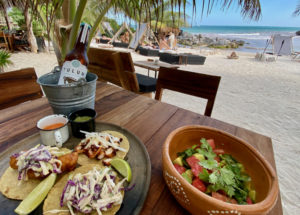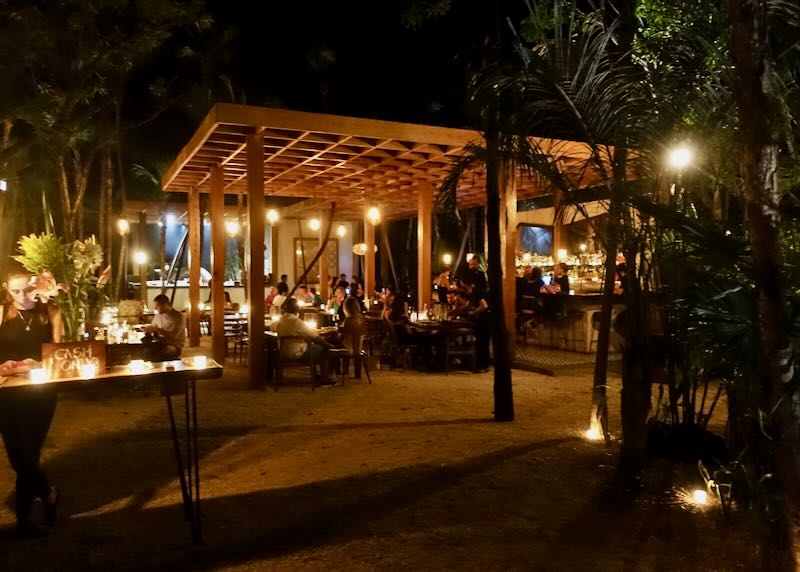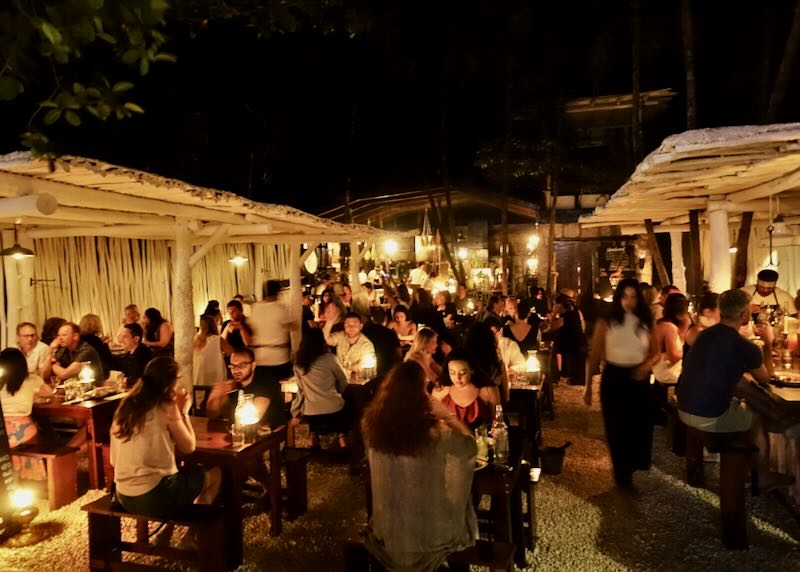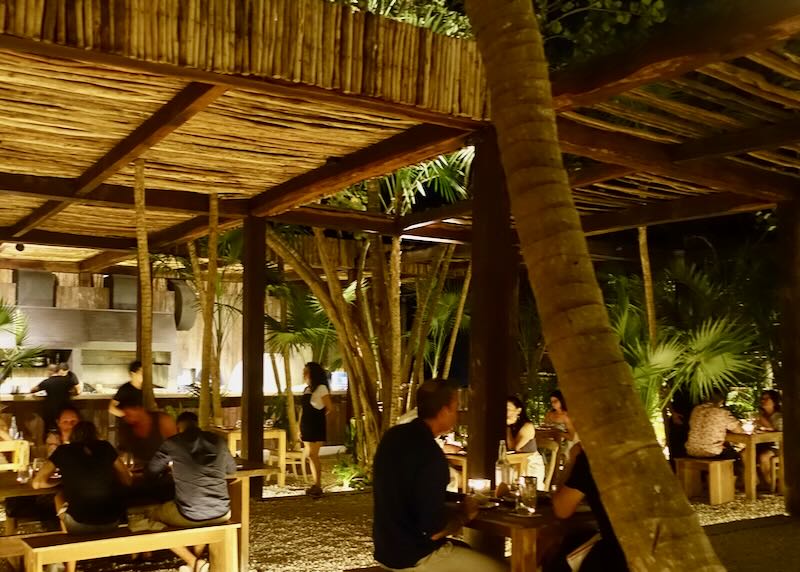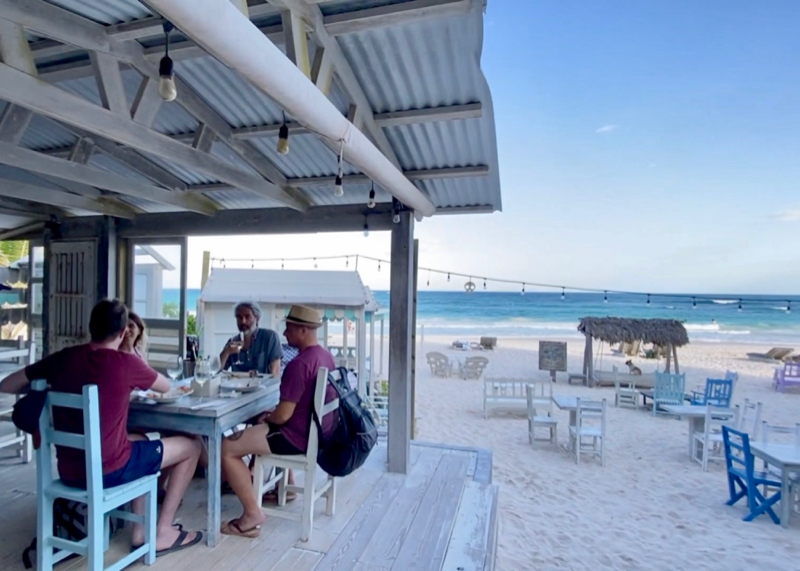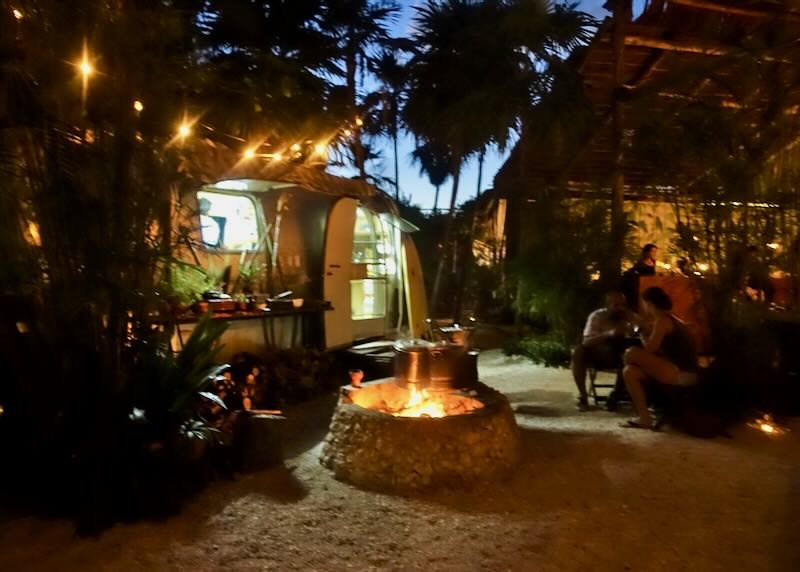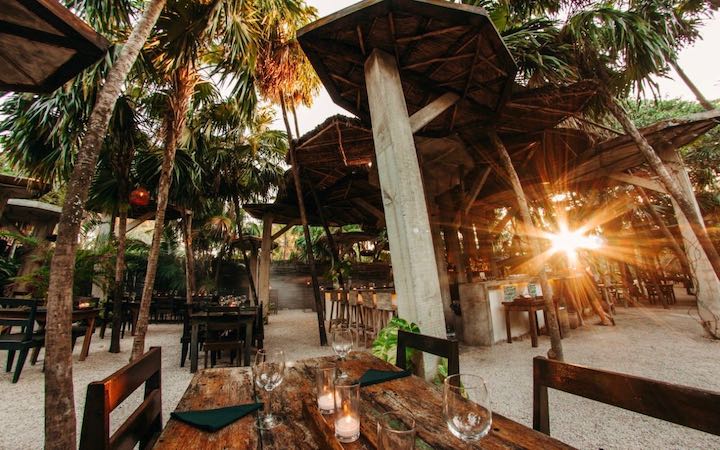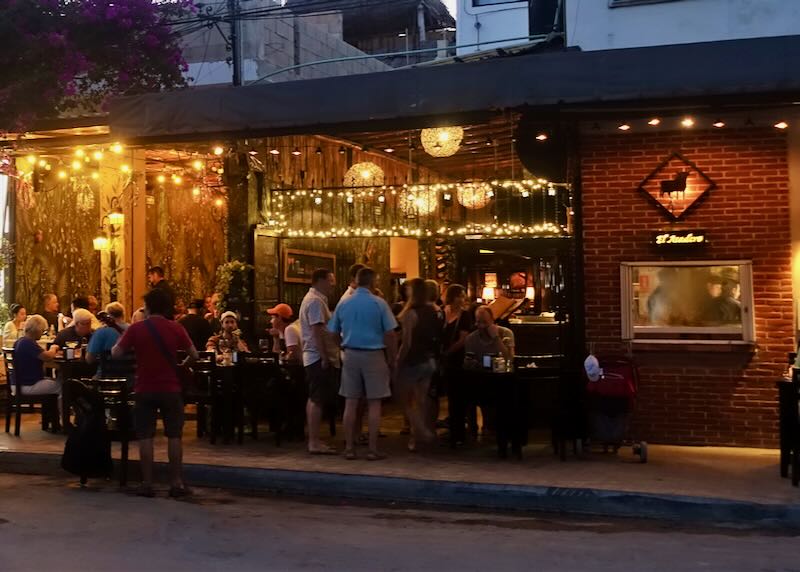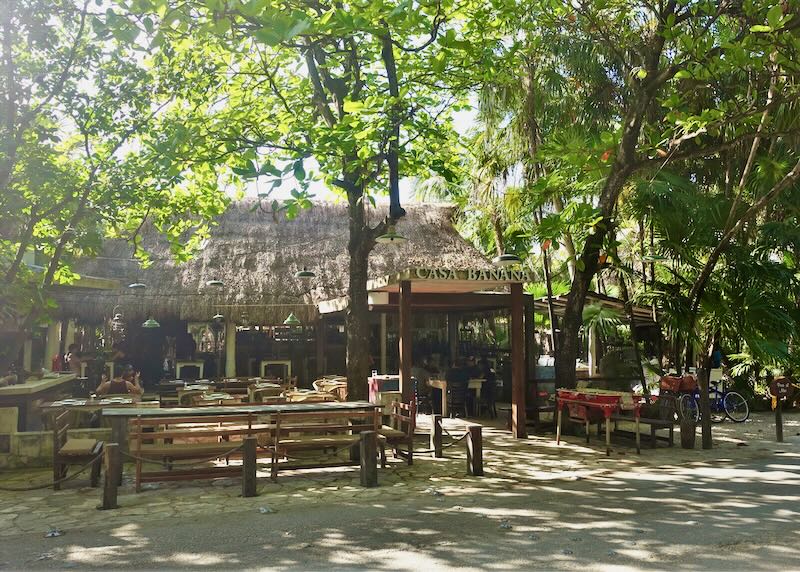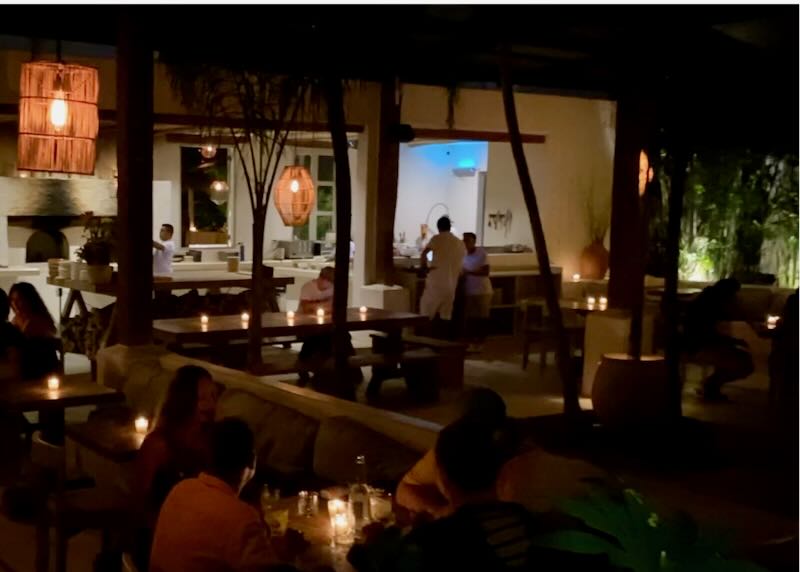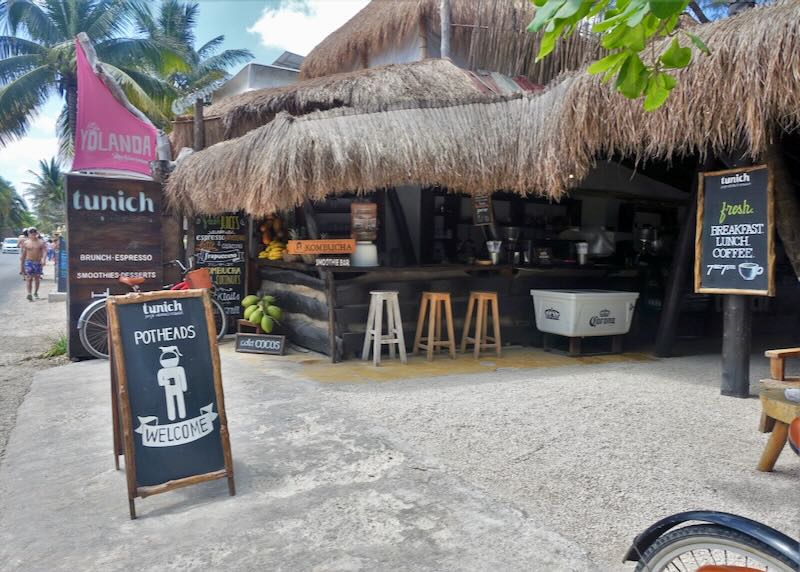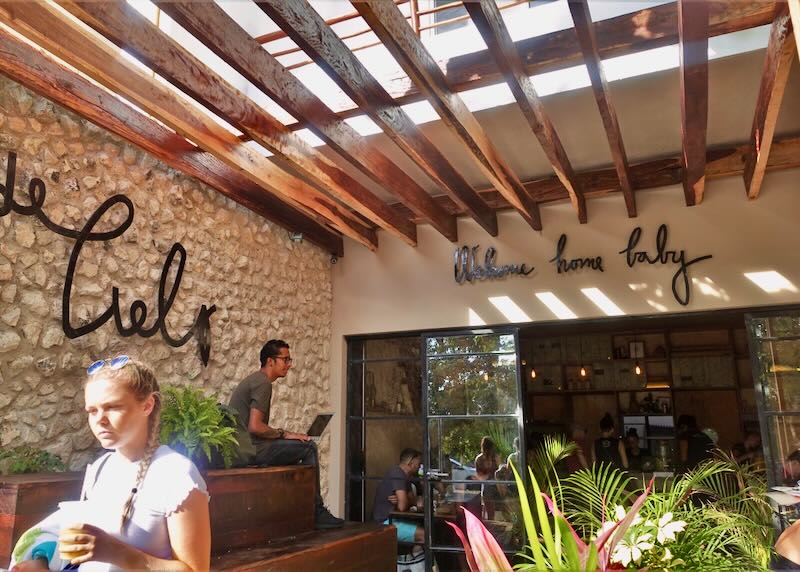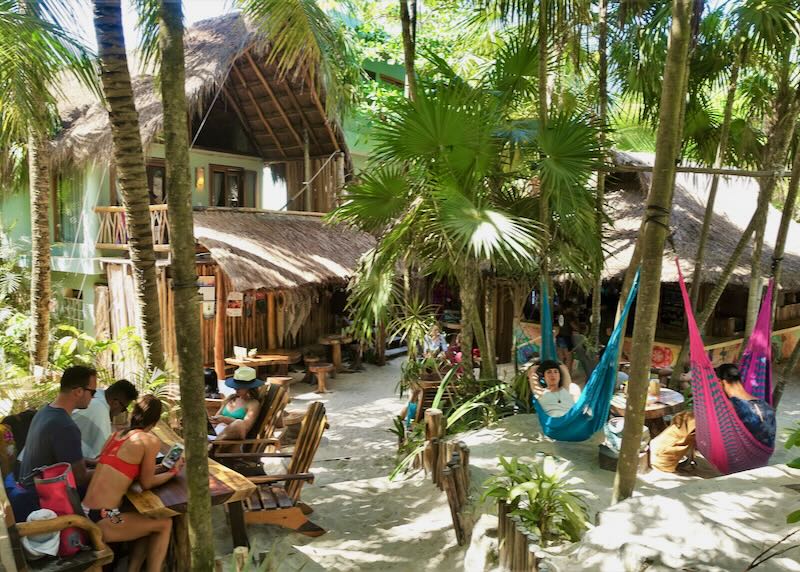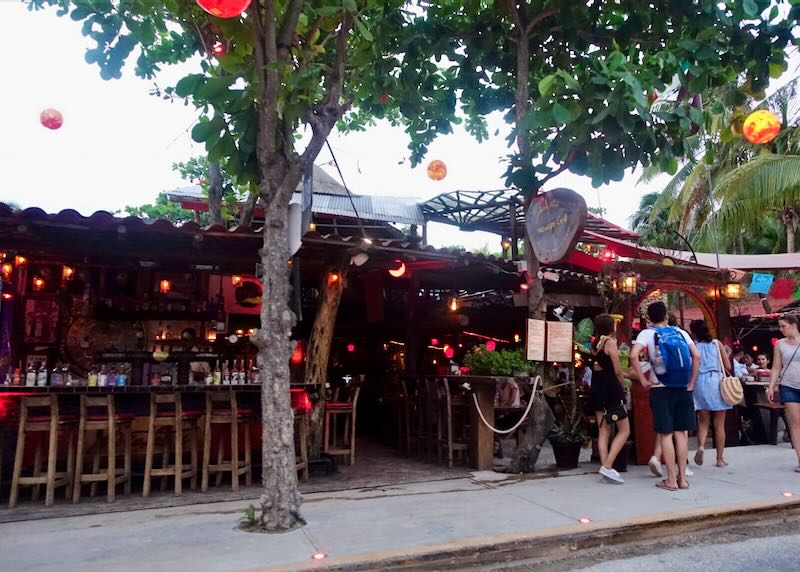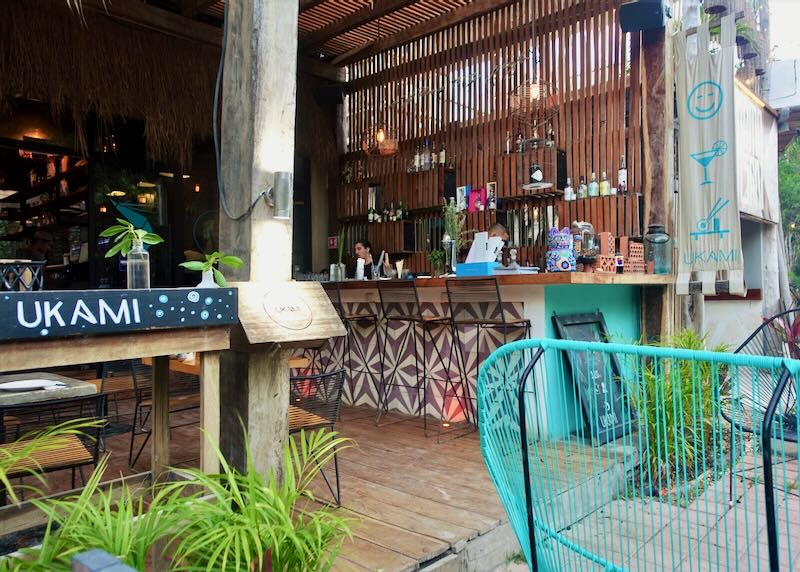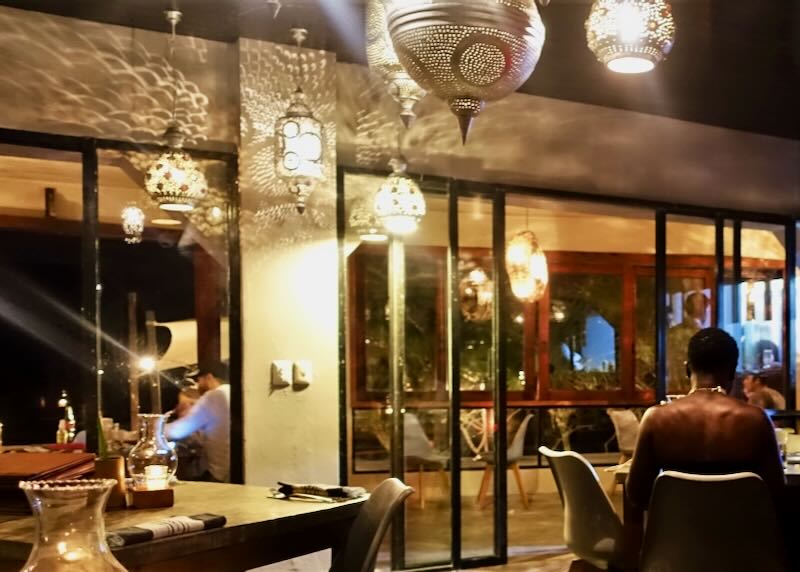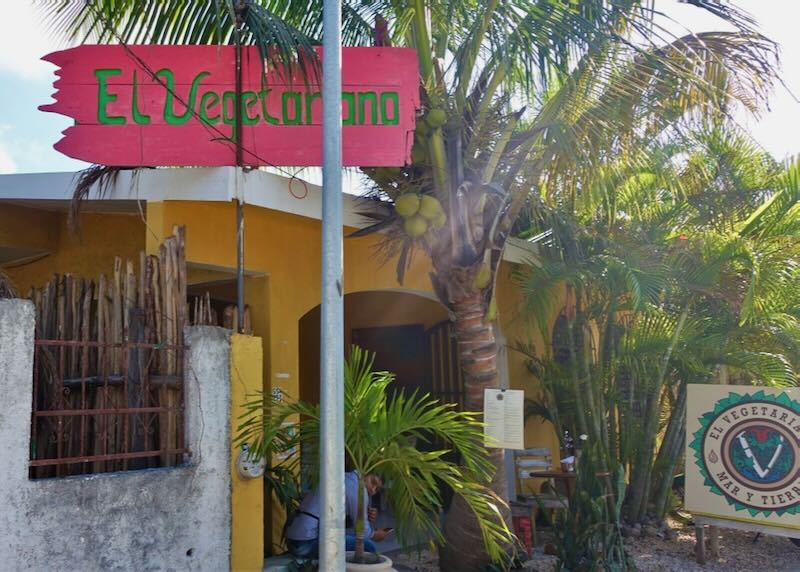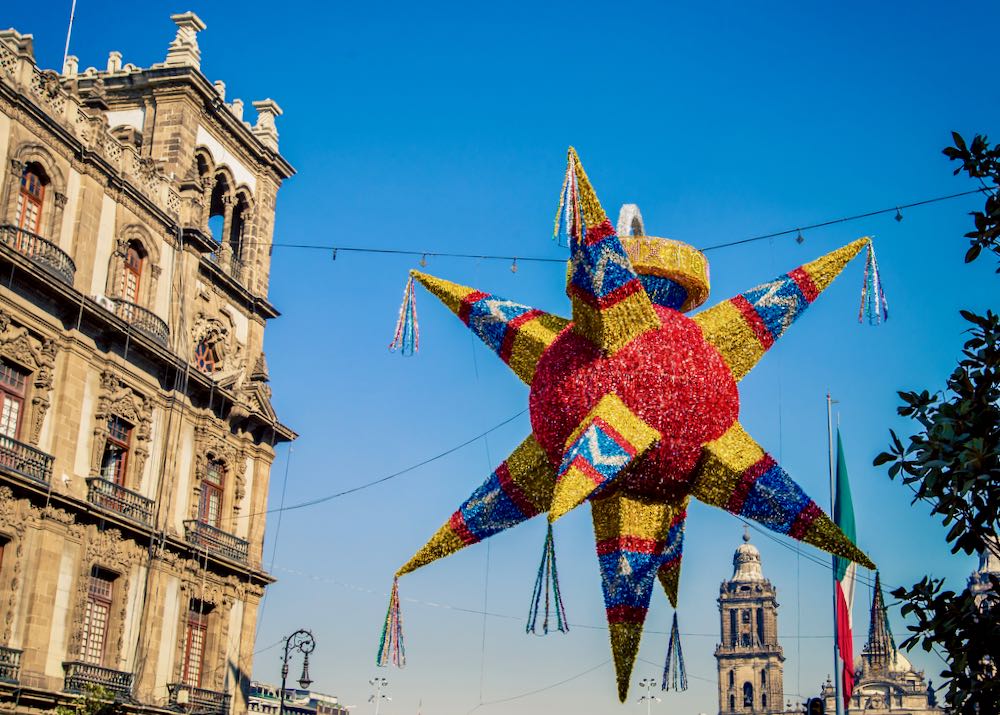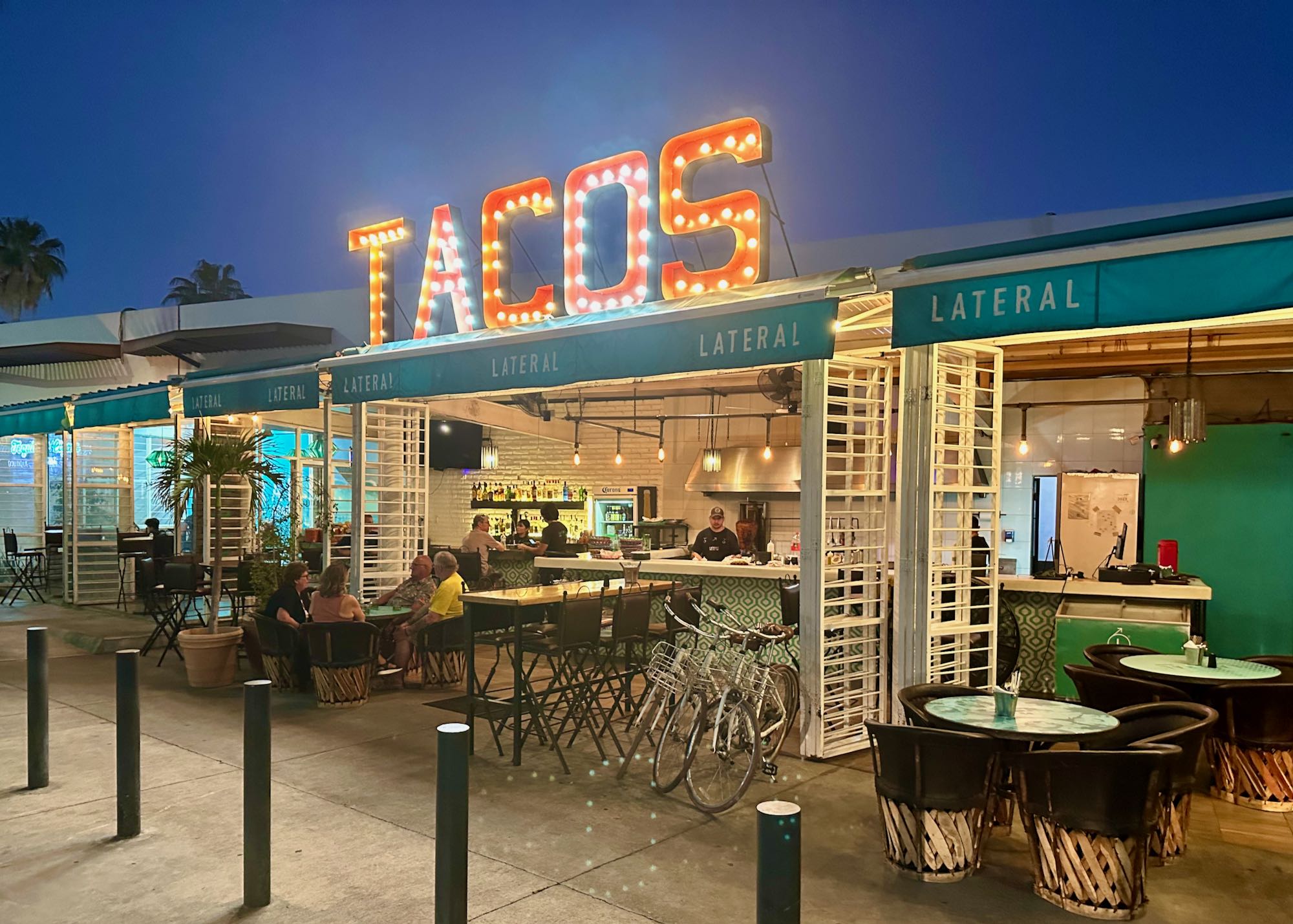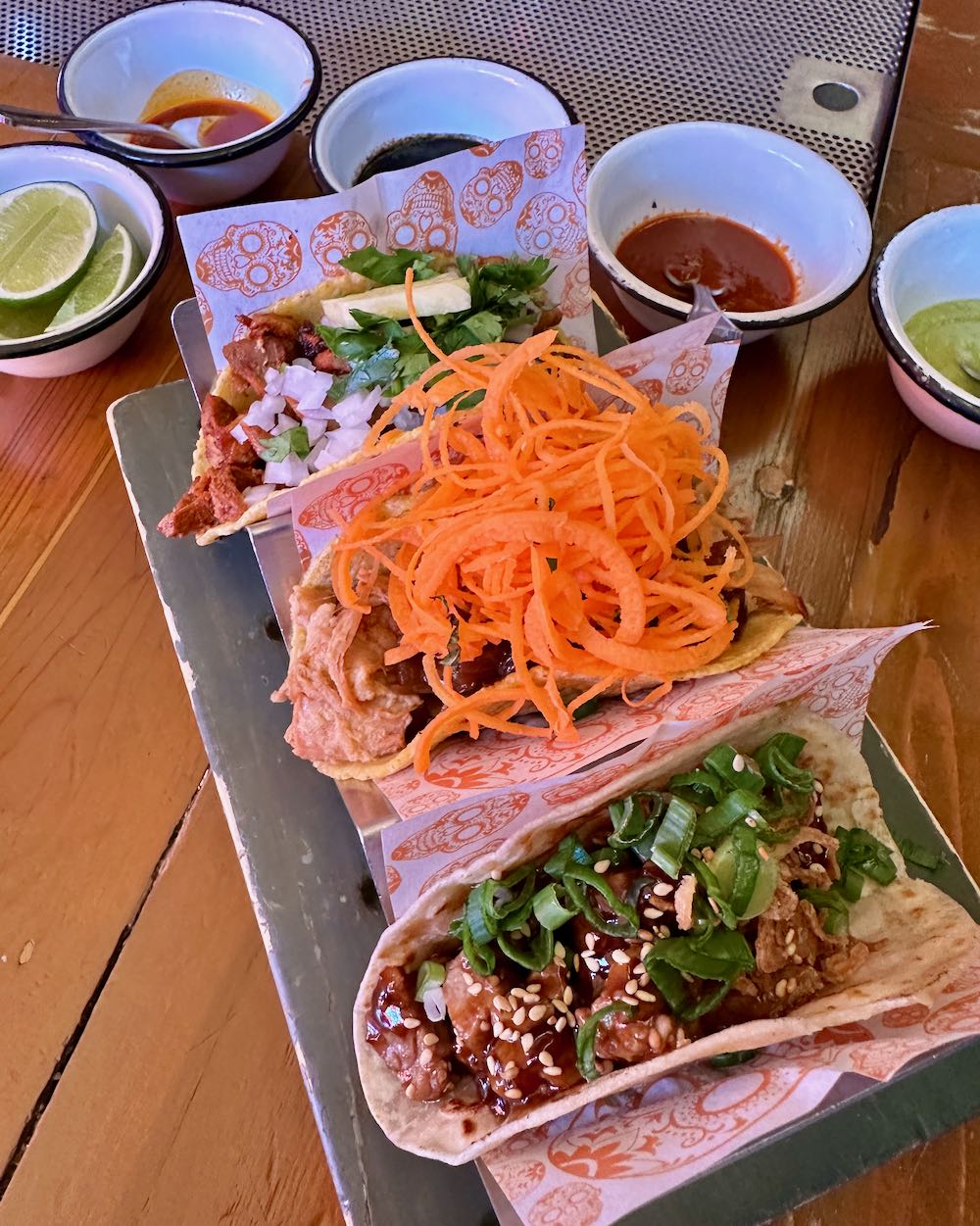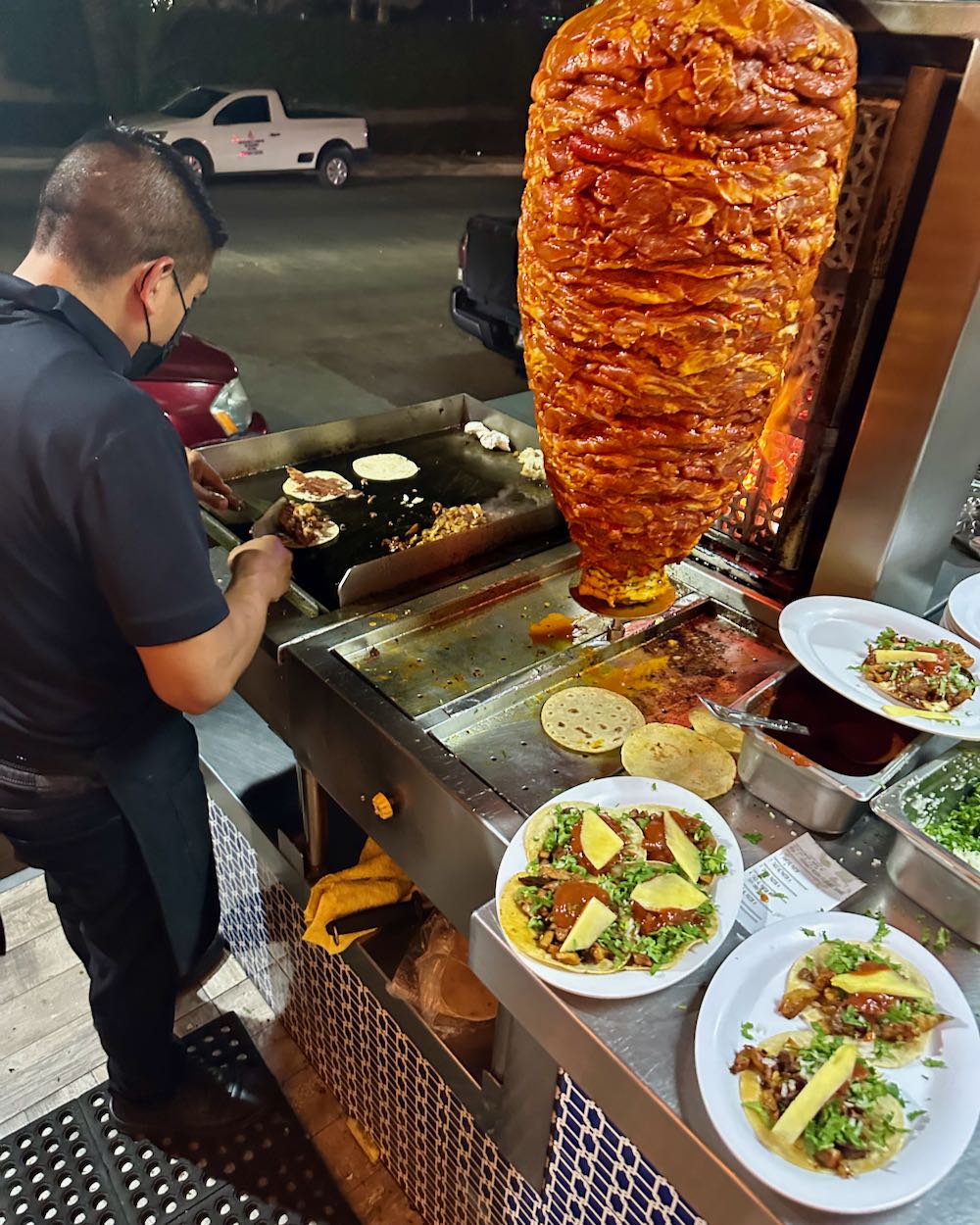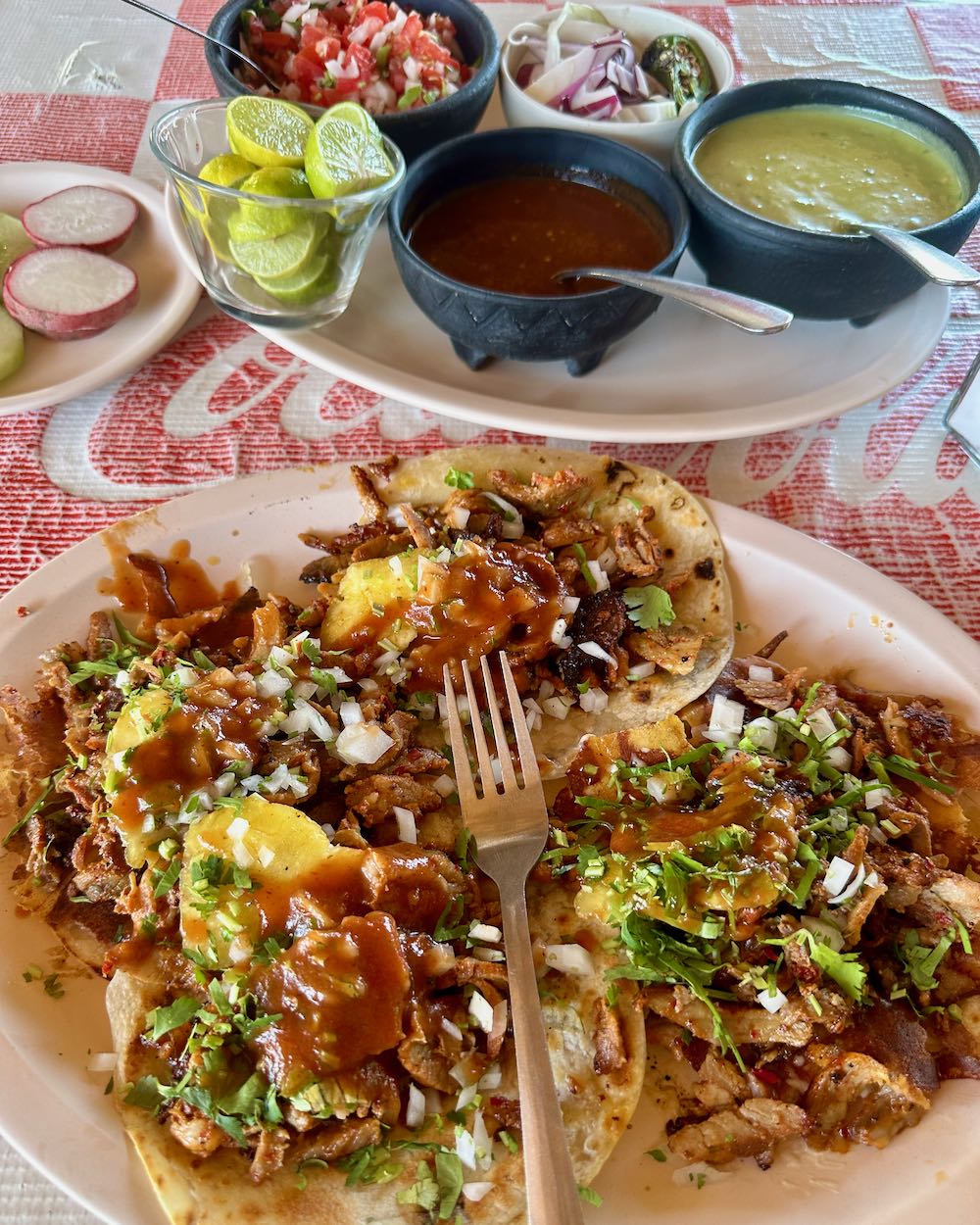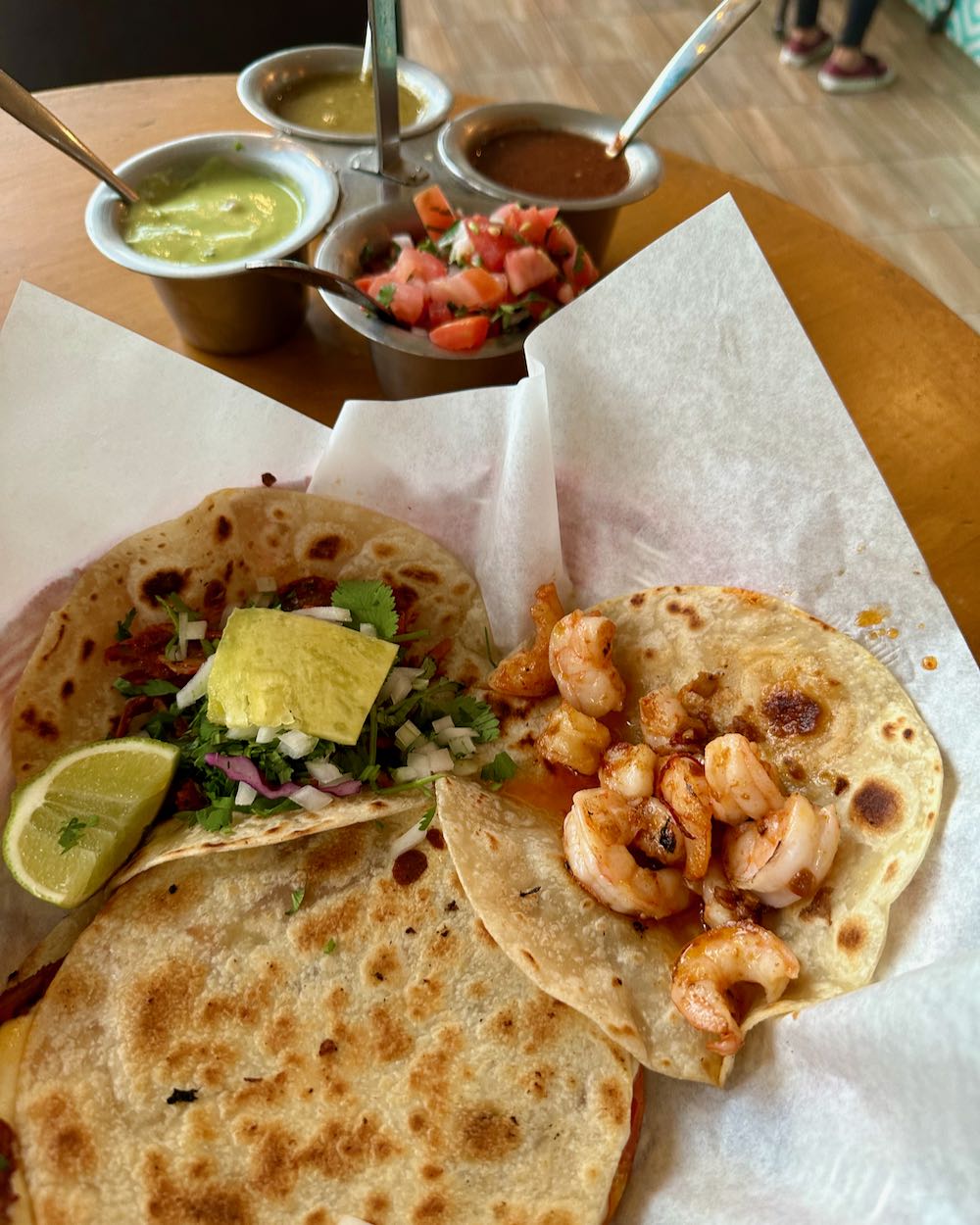Mexico › Tulum
Updated: February 20, 2024
The 85 best hotels, restaurants, shops, nightlife, cenotes, beaches, tours, neighborhoods, and things to do in Tulum, Mexico.
Tulum Articles
- Best Time of Year to Visit Tulum
- Best Restaurants in Tulum
- Best Bars and Clubs in Tulum
- Best Tacos in Tulum
- Best Cenotes in Tulum
- Biking in Tulum
- Maps of Tulum
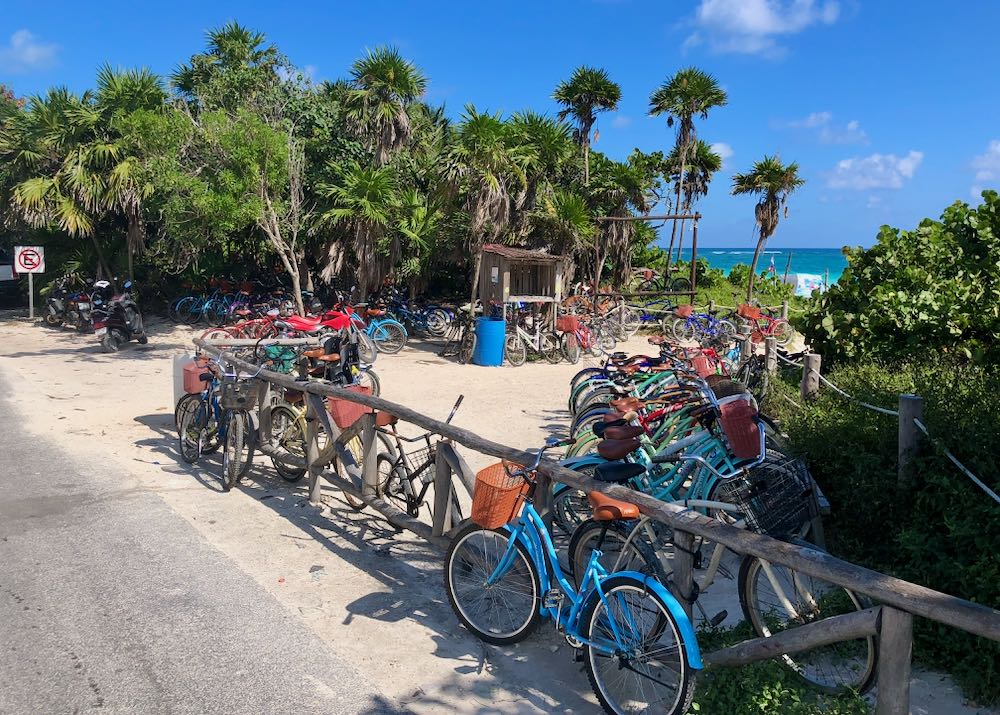
Tulum Hotels
1. Mezzanine • North Beach Zone • $$$$
Luxe, oceanfront, boutique hotel with a pool and Thai restaurant. Rooms and suites all come with yoga mats, minibars, and daily delivery of coffee and tea; master suites add soaking tubs and large private terraces overlooking the beach. Located just a few steps from one of Tulum’s best beaches and a short bike ride from the ruins. • Hotel phone: +52 984 131 1596 • Review2. Jashita • Soliman Bay, north of North Beach Zone • $$$$
Family-friendly, luxury boutique hotel on a semi-private beach. Jashita Hotel features 3 pools, beachfront service, a Mexican-Italian fusion restaurant, and a spa with shaman ceremonies. All rooms have king-sized beds and private terraces; top tier suites add private pools. The hotel sits on Soliman Bay near Casa Cenote and about 10 km north of the Tulum ruins. • Hotel phone: +52 984 875 4158 • Review
3. Casa Malca • South Beach Zone • $$$$
Stylish hotel with 2 pools, 3 restaurants, and an upscale beach club. Junior and master suites are all spacious and private, while the entire property is filled with contemporary art and eclectic decor. The hotel is family-friendly throughout the year, except for the weeks surrounding New Year’s Eve when it becomes adults-only during Tulum’s EDM festivals. Located on a sandy beach just a 10-minute walk to amazing restaurants and Sian Ka’an Biosphere.
• Hotel phone: +52 984 167 7154 • Review4. La Valise • South Beach Zone • $$$$
An upscale beachfront hotel with 2 plunge pools and 24-hour air conditioning (a rare luxury in the beach zone). La Valise’s onsite restaurant serves breakfast and lunch on the beach, while their sister restaurant serves Mexican fine dining in the evening under the jungle canopy. The hotel sits on a quiet stretch of wide, sandy beach just a short walk to amazing restaurants, nightlife, yoga studios, and spas.
• Hotel phone: +1 305 999 1540 • Review5. La Zebra • South Beach Zone • $$$$
Perfect for families, this beachfront boutique hotel offers a rooftop infinity pool, luxury spa, and a playground. Suites are designed for up to 4 with a king bed and twin trundle beds; the best suites add private plunge pools. Every Sunday, La Zebra hosts a kid-friendly salsa night with free lessons, an open dancefloor, and a live band.
• Hotel phone: (+52) 984-115-4728 • Review6. Tago • Middle Beach Zone • $$$$
Luxury beach hotel with huge rooms, all featuring private plunge pools. Tago’s all-day restaurant serves Mexican dishes crafted with local ingredients and Mediterranean influences. Great restaurants are just a short walk or bike ride away. • Hotel phone: +52 998 880 5629.
7. Ahau • Middle Beach Zone • $$$$
Ahau offers the quintessential Tulum experience: an outstanding wellness and yoga program, funky-chic rooms, and a sandy beach with a kitesurfing school. The hotel’s restaurants offer fantastic vegan and meat menus with fresh ingredients grown by local, Maya farmers. Located near many of Tulum’s best restaurants and nightlife. • Hotel phone: +52 984 147 5225 • Review
8. Nômade • South Beach Zone • $$$$
Eclectic, Bohemian, boutique hotel with air-conditioned tents, suites, and villas, many with private pools and outdoor showers. Their yoga and wellness program is steeped in Maya traditions with healing rituals and shaman ceremonies. Food is healthy and delicious at both Macondo (vegan/vegetarian) and La Popular (seafood) restaurants. Nômade sits right on the beach about a 10-minute walk to Sian Ka’an Biosphere. • Hotel phone: +52 984 803 2243 • Review
9. Una Vida • Pueblo • $$$
The most luxurious hotel in the Pueblo, Una Vida features a refreshing pool, daytime restaurant, and free bicycles. Large suites offer up to 3 bedrooms and sleep up to 8 guests; all studios and suites have kitchenettes and outdoor showers or bathtubs. Private dining, tequila/mezcal tastings, and in-room yoga/massage sessions are available on request. • Hotel phone: +52 984 240 5231 • Review
10. Sueños • South Beach Zone • $$$
Maya-themed, eco-friendly hotel with a pool, yoga studio, and restaurant. All suites feature private decks with hammocks, while the penthouse adds a stone jacuzzi. Sueños sits on a quiet stretch of beach, surrounded by beach clubs and restaurants, just a short bike-ride to Sian Ka’an. • Hotel phone: +52 984 119 3484 • Review
Tulum Restaurants
11. Arca • Middle Beach Zone • $$$$
An upscale, farm-to-table restaurant on the jungle side of Tulum’s beach road, Arca offers an ever-changing selection of local meat, seafood, and produce all cooked over a fire. Recipes draw from local Maya traditions and contemporary techniques. Dinner only; open Tuesdays through Sundays; reservations recommended. • Map • +52 984 111 5379.
12. Hartwood • Middle Beach Zone • $$$$
Hartwood is Tulum’s premier, fine dining restaurant. Each evening a new dinner menu highlights seasonal produce from local, Maya farms along with sustainably caught seafood cooked over an open flame. This off-grid restaurant offers open air seating and is lit by candlelight only. Dinner only; open Wednesdays through Sundays. Reservations are accepted one month in advance by email ([email protected]). • Map • +52 555 202 0030.
13. Cetli • Pueblo • $$$
Serving elevated, traditional Mexican cuisine in an art-filled hacienda, Cetli is the best restaurant in the Pueblo. Mole (the sauce, not the animal) is the specialty here, with several varieties all prepared in pre-Hispanic style with fresh, local ingredients ground with a metate stone. The restaurant is open all day, but dinner service is when the restaurant shines. Reservations are recommended for dinner but are not necessary during the day. • Map • +52 984 108 0681.
14. La Gloria de Don Pepe • Pueblo • $$
Cozy tapas restaurant serving Spanish-Mediterranean fare and excellent wines. La Gloria is best loved for their paella (takes about 30 minutes, so order appetizers for the wait), though their fideuà (seafood pasta), chistorra sausage, and various tapas are all amazing. Lively atmosphere in the evenings. Open for lunch and dinner; cash only. • Map • +52 984 152 4471.
15. NÜ Restaurant • South Beach Zone • $$$$
Contemporary, upscale Mexican restaurant in a stylish, jungle setting. The menu focuses on traditional ingredients with a modern spin; all dishes are prepared with care and artistry. NÜ is ideal for romantic occasions and special celebrations. Dinner only; reservations strongly recommended. • Map • +52 558 060 2747.
16. Posada Margherita • Middle Beach Zone • $$$$
Posada Margherita is a picturesque, beachfront Italian restaurant. All pasta is made to order by hand, the pizza is a family recipe passed on through the generations, and the well-curated wine list changes regularly. The restaurant is open all day, though the lunch/dinner menu is best. Cash only; no reservations. • Map • +52 786 472 3438.
17. Safari • Middle Beach Zone and Aldea Zama • $$
Campfire cuisine with an innovative, rustic menu and open-air seating in the jungle. Safari serves Yucatecan-Mexican dishes all prepared in an airstream trailer kitchen and cooked outside over a fire pit. The food pairs perfectly with their signature cocktails, Mexican craft beers, and aguas frescas. The beach location is the original restaurant, but they have recently opened a second spot in Aldea Zama. The Aldea Zama spot is indoors, but the food is still fire-cooked. The beach location is open for lunch and dinner, cash only. Aldea Zama adds a breakfast service and accepts credit cards. • Beach Map • Aldea Zama Map • +52 984 745 2340.
18. Clan-Destino • Middle Beach Zone • $
Great little bar and burger restaurant set in the jungle with a private cenote. The simple menu offers meat or veggie burgers, strong cocktails, and beer. Virgin Cenote at the restaurant’s heart is illuminated at night by a chandelier and supposedly restores the virginity of anyone who swims in it. Offering a jukebox, karaoke, and live music, this casual spot offers a fantastic break from the chichi restaurants lining the beach. Open from noon until 5:00 in the morning. • Map • +52 984 169 5353.
19. WILD • South Beach Zone • $$$
Stylish, jungle restaurant serving creative Mexican-international cuisine cooked over an open flame and highlighting local ingredients. WILD’s sophisticated cocktail menu was designed by the French/Ibezan celeb mixologist Nicolas Baptiste, blending cosmopolitan and regional tastes. Ideal for weddings and special events. Reservations recommended. • Map • +52 984 130 8295.
20. El Asadero • Pueblo • $$
El Asadero is the best steakhouse in Tulum, offering perfectly cooked cuts, a romantic ambiance, and live music nightly. The house specialty is arrachera (marinated skirt steak) served with chorizo, potatoes, and grilled cactus. Open for dinner only; reservations recommended. • Map • +52 984 157 8998.
21. Casa Banana • South Beach Zone • $$$
This upscale, Argentine restaurant is the best steakhouse in the beach zone. The stars of the menu are the flame-grilled steaks and homemade chorizo along with a selection of smoky, mezcal-based cocktails and local beer. The restaurant is open all day, though dinner is their strong point. • Map • +52 984 806 2871.
Tulum Tacos
22. Taqueria Honorio • Pueblo • $
Semi-famous, family-run taco stand serving tacos and tortas stuffed with Yucatecan specialties, including conchinita pibil, lechón al horno, poc chuc, relleno negro, and more. Seating is at the small bar in front of the cart, plus there are a few long tables and plastic chairs under a tent. Honorio’s tacos are in high demand, so expect to wait and to pay a little more than at other taquerias in the Pueblo. Open from 6:00 a.m. until they run out of food, usually around 1:00 or 1:30 p.m. Cash only. • Map • +52 998 102 0523.
23. Taqueria El Carboncito • Pueblo • $
The best pastor tacos in Tulum, though their chorizo and beef tacos and tortas are also stellar. Order the tacos con piña (with pineapple) and with a glass of jamaica (sweet hibiscus tea) or horchata (sweet cinnamon rice drink). This super casual, affordable, open-air restaurant is popular with locals and travelers alike, so there is often a wait for a table. Ordering to go is often faster. • Map • +52 984 256 6451.
24. Los Antojitos la Chiapaneca • Pueblo • $
Amazing street tacos for only 10 pesos each (15 pesos with cheese), plus killer empanadas, panuchos, and salbutes. This bustling little snack shack offers covered or outdoor seating, but it’s always packed, so be ready for a wait or order to go. Hours vary, but Los Antojitos la Chiapaneca is usually open after 5:00 p.m. Cash only. • Map • +52 984 112 3249.
25. Tacos y Tortas El Tio • Pueblo • $
Fantastic little street vendor with cheap, delicious tacos, tortas, and gringas. There are only 5 chairs around the countertop at this popular spot, so plan on taking everything to go. The cart parks in front of the Oxxo at the intersection of Avenida Tulum and Calle Geminis Sur. Cash only. Nights only, usually on the weekend. • Map
26. Burrito Amor • Pueblo • $$
OK, burritos aren’t tacos, but Burrito Amor offers an outstanding menu featuring homemade tortillas (flour, gluten-free, or grain-free) filled with delicious stuffings (meat, vegetarian, vegan, egg-free, dairy-free, or paleo-friendly fillings). With a focus on clean eating, this restaurant serves fresh, healthy meals that still deliver a ton of flavor. There is also a full bar boasting a variety of signature cocktails, plus aguas frescas, coffee, and fresh juices. Open for breakfast, lunch, and dinner. • Map • +52 984 160 2989.
27. Charly’s Vegan Tacos • South Beach Zone • $
Outstanding taco shop on the jungle side of the beach road serving a mouthwatering range of 100% vegan tacos and snacks. The mock meats are especially well-done – hearty and flavorful enough to satisfy meat-eaters (especially the porkless cracklings), while their spin on guacamole, Guaca-Mango, is legendary. Charly’s charming setting with hanging lights and candles under a canopy of palm trees give this the best atmosphere of any taco shop in Tulum. • Map • +52 998 102 0523.
Tulum Cafes, Bakeries, and Sweets
28. Ki’bok Coffee • Pueblo • $$
The best coffee in Tulum. Ki’bok’s signature espresso drink, the Hemingway, is their version of a cortado, though the iced latte is their most popular order. For breakfast, try the huevos rancheros or the divorced eggs (cooked in two different salsas). Ki’bok has a walk-up bar under a thatched awning and a covered garden out back open all day. At night the rooftop bar opens with wonderful cocktails, music, and a chilled out vibe. • Map • +52 984 135 9509.
29. Campanella Creamerie • Pueblo • $
Outstanding gelateria and cafe known for their gelato-topped Belgian waffles. The gelato itself is top-notch, on par with the best in Italy – ask for the hazlenut or pineapple basil. Great coffee and sandwiches, too. Open until 11:00 p.m., but arrive early before they start running out of flavors. • Map • +52 984 871 2992.
30. Del Cielo • Pueblo • $$
The best brunch spot in the Pueblo. Del Cielo serves up a full menu of local, organic Mexican, Caribbean, and international dishes all with picture-perfect presentation. Famous for their breakfast and brunches (especially the tartine and French toast), Del Cielo has recently added a dinner service with handcrafted cocktails and a Mexican-Mediterranean menu. • Map • +52 984 160 0770.
31. Potheads • Beach Town • $$
The best breakfast and brunch on the beach road. Tunich boasts a solid menu of brunch and lunch items all day, from 7 a.m. to 7 p.m. The menu features Mexican favorites, like chilaquiles and breakfast burritos, alongside stellar eggs benedict, pancakes, and French toast. Hearty portions are served up in a friendly, casual atmosphere. • Map • +52 984 112 1335.
32. El Gourmet • Pueblo • $$
A charming little cafe with fantastic veggie and meat paninis, great coffee, fresh juice, and rich desserts. El Gourmet bakes their bread fresh daily, and all paninis can be made with focaccia on request (you can also order bread on its own to go). Salads are made with high-quality, fresh, local produce and cheeses. The dining patio sits in a cheerful garden with rows of rainbow umbrellas overhead. • Map • +52 984 202 7048.
33. Panna e Cioccolato • Pueblo • $
Sweet little gelato shop with a range of traditional Italian and signature Mexican flavors, served in fresh, handmade waffle cones. Not much seating, so plan to take it for a stroll. Two locations in the Pueblo, both on Avenida Tulum, open all day until 11:30 p.m. • Map of the western location • Map of the eastern location • +52 984 140 9531.
34. Raw Love • Middle Beach Zone • $$
Stylish, raw vegan restaurant serving a gourmet menu of gluten-free superfoods in a boho setting with a rope swing, hammocks, and a sandy floor. Menu standouts include the açai bowl and raw pad thai. The restaurant is located inside Ahau Tulum’s property where the jungle and beach meet. Open from 9:00 a.m. to 6:00 p.m. • Map • +52 984 130 2013.
35. La Fourneé • Pueblo • $
The best bakery in Tulum. La Fournee offers a wide selection of French pastries, breads, and cakes. They also offer all-day dining on their back patio with an especially great brunch and lunch menu of crepes, sammies, salads, and great espresso drinks. Open all day, usually into the late evening. • Map • +52 984 130 9928.
Tulum Bars and Clubs
36. Batey Mojito & Guarapo Bar • Pueblo • $$
Batey is the heart of the Pueblo’s nightlife. The bar is known for their hand-crafted mojitos made with fresh sugarcane juice pressed in a converted VW bug. Live music most nights. Tacos and tapas are on the trendy/expensive side. The bar gets packed at night but is more relaxed during the day. On Tulum’s weekly party rotation, Batey is the place to be on Tuesdays and Wednesdays. • Map • +52 984 745 4571.
37. Casa Jaguar • Middle Beach Zone • $$$
Chic Caribbean restaurant and bar with a boutique and chai house attached. Casa Jaguar is Tulum’s hot spot on Thursday nights with jungle parties on their sexy, candlelit back terrace, featuring local and international DJs with dancing from 11:00 p.m. into the wee hours. Thursday is the main party night here, but they also host jungle parties on Tuesdays and select Saturdays. • Map • +52 984 202 2464.
38. Gitano • Middle Beach Zone • $$$
Contemporary Mexican restaurant in the front and mezcal bar in the back, located on the jungle side of the beach road. Gitano is the place to be on Friday nights, with DJ sets, dancing, and drinks – the signature cocktails are slow to make but worth the wait. Gitano opens for dinner nightly at 6:00; reservations strongly recommended. Fridays and Saturdays are lively DJed dance nights starting at 11:00; Sundays, Wednesdays, and Thursdays Gitano hosts live music starting earlier in the evening with a more chilled out vibe. • Map • [email protected].
39. Papaya Playa Project • Beach Town • $$$
Papaya Playa Project hosts the biggest, wildest parties in Tulum every Saturday, but their Full Moon Parties are totally over the top, held monthly on the Saturday closest to the full moon with top-name DJs and dancing until 3:00 a.m. or later. Cover charges vary, but expect to pay at least $25 to get in. Parties usually start around 11:00 p.m. but don’t really get going until after midnight. For the major parties (usually in December and January and especially on New Year’s Eve), there can be 1000 to 3000 attendees easily, so buy tickets in advance and arrive early to avoid the line, which can be up to 3 hours long. Groups should consider reserving a table. • Map • WhatsApp: +52 1 984 179 8516.
40. Sunday Salsa Night at La Zebra • South Beach Zone • $
Every week La Zebra Hotel hosts a salsa dance party. Free salsa lessons are held from 6:30 to 7:30, after which a live band takes over and guests can enjoy over 3 hours of dancing. The main restaurant and bar remain open for drinks during the party, but the best drinks are found at their beach bar The Mulberry Project, serving handcrafted signature cocktails with mezcal, tequila, and rum. No cover charge; family friendly. • Map • +52 1 984 115 4726.
41. Kin Toh • Beach Town • $$$$
Kin Toh is by far the best looking restaurant in Tulum, but the food is for adventurous eaters only. However, the bar/shisha lounge is amazingly cool: outstanding mixology, sultry ambiance, treehouse design, and sunset views over the jungle canopy. The layout features outdoor “nests” above the treeline and indoor islands of oversized papasan-like tables. Between the tables are catamaran nets suspended in the air and covered in pillows for lounging. Reservations recommended for sunsets, dining, or groups but not necessary for visiting the bar. • Map • +52 984 980 0640.
42. Kiki • Pueblo • $
Kiki is the one and only nightclub in Tulum and attracts a good mix of locals and travelers alike, with a crowd that skews young thanks to the nearby hostels. Drinks are strong and affordably priced and the DJs are fantastic. Doors open at midnight, and the party gets going around 1:00ish until 6 or 7 in the morning. Kiki is always open Wednesdays through Saturdays and is sometimes open other days, too (check their Facebook page for updates). Usually no cover charge and often 2 for 1 drinks from midnight until 2:00 a.m. • Map
43. Pasito Tun Tun • Pueblo • $
Awesome little bar specializing in mezcal cocktails plus plenty of well-made classics and a great menu of light bites. The atmosphere is friendly and laid back in the early evenings. After 10:00, Pasito Tun Tun hosts live bands and DJs spinning deep house and electro-cumbia. A popular hangout for locals, expats, and travelers alike. • Map • +52 984 688 8550.
44. I Scream Bar • Middle Beach Zone • $
Combination bar, vegan/gluten-free/sugar-free ice cream shop, and meat and seafood-based taco shop. The specialty of the house are ice cream shots: scoops of their handmade ice cream with tequila or mezcal poured over the top. I Scream Bar is located in a beach-chic shack made of recycled VW bus parts complete with working headlights. Quiet in the day, spirited at night, good vibes anytime. • Map • +52 984 169 5353.
Tulum Shopping
45. Caravana • Middle Beach Zone • $$$$
Chic, Maya-inspired clothing and accessories with dramatic flair. All items are handcrafted by Mexican artisans in Vallodolid using traditional methods and materials. • Map • +52 985 119 0361.
46. Zak Ik • Beach Town • $$$$
Handmade, jungle-inspired designer clothing and accessories made with fair trade practices and eco-sourced materials. Attached to Azulik Hotel, the boutique features stunning design with footpaths over shallow pools, walls made of woven branches, and soft lighting – more like an art installation than a shop. Definitely worth a look, but be advised they do not allow children at all, no exceptions. • Map • +52 984 236 0935.
47.Josa Tulum • Middle Beach Zone • $$$
Well-known women’s clothing boutique for simple, elegant dresses and accessories. The dresses are all long with caftan-inspired cuts, one-size-fits-all, made of either jersey or chiffon, and designed to effortlessly move from day to evening. Open every day from 10 a.m. to 10 p.m. • Map • +52 984 115 8441
48. La Llorona • Middle Beach Zone • $$
Wonderful artisan boutique jam-packed with clothing, crafts, and decor, all locally made, a lot handmade, and all carefully curated by the artist owners. The traditional Maya and contemporary Mexican designs feature bright colors and bold patterns. The shop also offers local antiques upstairs. • Map • +52 984 116 3048.
49. Mixik • Pueblo and Beach Town • $$
Fantastic little gift and souvenir shops offering authentic, affordable crafts and trinkets that are 100% made in Mexico. Plenty of beadwork, glass art, embroidery, jewelry, and more. The Pueblo location is the larger of the two with a broader selection. • Pueblo Shop Map • Beach Town Shop Map • +52 984 871 2136.
50. Mr. Blackbird • South Beach Zone • $$$
This small shop offers handmade jewelry (for men and women), sandals, accessories, and home goods. Small production runs and one-of-a-kind pieces are all created by the owners and local artisans in an eclectic, graceful style.
• Map • +52 984 114 3796.51. teepee • Middle Beach Zone • $$$
In the busy mid-section of the beach road across from Ahau Hotel, there’s a charming boutique in a white teepee. Inside, there is a spare selection of handmade clothing and accessories: caftans and dresses made from re-purposed vintage fabrics, eclectic jewelry, and rustic slippers and sandals. The shop has no name, no phone, and no website. Hours vary, but the boutique is generally open at least from mid-morning to mid-afternoon. • Map
52. Northeast Tulum Shops • Avenida Coba, northeast of the Pueblo • $-$$
Several open-air shops line Avenida Coba on the way to the Cobá ruins, selling rustic-chic home decor, garden furnishing, and art – everything from rough-hewn tables to hanging nest chairs and from brightly painted bathroom sinks and toilets to life-sized Day of the Dead statues. The first of the shops sits about 21 km from the Pueblo in the village Macario Gómez running northeast along the road for about 3 km, ending just outside of the village Franciso Uh May. Most shops here accept cash only. • Map of Starting Point • Map of Ending Point
Tulum Beaches
53. Playa Paraíso • North Beach Zone
Playa Paraíso aka Playa Maya is a white, sandy beach lined with palm trees and a few beach clubs scattered around. Several affordable snorkel tours depart from here throughout the day, no advanced reservations necessary. One of the quieter beaches in Tulum. • Map
54. Tankah Beach • Soliman Bay, north of Tulum
Quiet, well-maintained, white sand beach off the beaten path north of Tulum. Protected by its proximity to the reef and Cozumel Island, Tankah Beach has gentle surf with hardly any waves, perfect for beginning swimmers. The clear waters, coral reef, and native sea turtles make this a popular spot for snorkeling and kayaking. The beach sits on a private road, and even though all beaches in Mexico public, the security team at the entrance may ask where you plan on visiting. Tell them “Chamico’s,” the name of the only beachfront restaurant there. Supposedly 50 pesos for parking, but payment is not always enforced. • Map
55. Akumal Beach • Akumal, north of Tulum
Akumal Beach is a long, wide stretch of white sand fronted by a coral reef and teeming with sea turtles. But this beach has become super popular with tourists and dishonest tour guides trying to scam travelers. For the best chance of seeing the turtles, go before 9:00; the tourist hordes have not arrived yet to kick up sand and scare away the turtles and the tour guides have not shown up yet to try their scams. If arriving later in the day, here’s how it goes down: the guides will say that you have to snorkel in a designated area where they say all the turtles are (not true – the turtles roam free all throughout the bay), that everyone has to wear a life jacket (also not true – that’s only for the corralled area), and they will ask $35 per person for access to this special area (not true – entrance is free if you order anything from one of the restaurants or it’s 50 pesos to enter from the visitors center). The guides will also try to flag cars down at the front parking lot and overcharge for parking. Just ignore them; drive straight past them down the road. Parking here is only 20 pesos per hour, 50 pesos for the day, or free if you eat at a restaurant and use their parking. This all sounds like a hassle, but it’s really not; just ignore anyone trying to sell anything at the entrance. Once on the beach, it’s nice and calm. • Map
56. South Beach • South Beach Zone
The southern end of the South Beach Zone (from about km 8.5 to km 10) offers long, wide stretches of powdery sand and moderate waves. This area has a more relaxed atmosphere and fewer beach vendors than the North and Middle Beach Zones, because, though the South Beach is public, there are no public access points to reach it. Access is gained through the beach clubs and hotels there or by entering from farther north and walking down. For a truly luxurious beach experience, rent a cabana at Casa Malca or Nest’s beach clubs (reservations recommended). For a more low key beach experience, visit Om or Maalix’s Beach Clubs. • Map (starting point) • Map (ending point)
57. Ruins Beach and Santa Fe Beach • North Beach Zone
Just below the Tulum Ruins archaeological zone is a small beach with white sand and crystal blue water (sometimes a little choppy). Though located at the base of Tulum’s most popular attraction, Ruins Beach is surprisingly relaxed. The occasional tour group comes through, but most people just see the beach from the cliffs above. Access to Ruins Beach is gained by entering the archaeological site and taking a wooden stairway down, or strong swimmers can reach it by swimming up from Santa Fe Beach, about 500 meters south. Santa Fe Beach was one of Tulum’s original hangout spots before the tourism boom. Along with soft sand and turquoise water, there are a handful of casual beach clubs and affordable snorkel tours here. • Ruins Beach Map • Santa Fe Beach Map
58. Ziggy’s Beach • Middle Beach Zone
The Middle Beach Zone is the liveliest part of Tulum’s beachfront, lined with hotels, restaurants, beach clubs, and bars. This long, uninterrupted stretch of sugary white sand with turquoise water and moderate waves is considered one beach with no particular name. The best spot to enjoy the sun, sand, and sea in the Middle Beach Zone is Ziggy’s Beach, a fantastic all-day beach club serving top-notch food and drinks with plenty of sunbeds and umbrellas. Ziggy’s is better for families and groups, offering quiet days and live music nightly. • Ziggy’s Beach Map
Tulum Cenotes and Lagoons
59. Cenotes Dos Ojos • Tankah, northeast of Tulum • $$$
A visit to Dos Ojos (Two Eyes) is a must when in Tulum. The cenote group is named for its 2 largest cenotes, the Blue Eye (open-air, crystal blue water, great for snorkeling) and the Black Eye (a pitch black cave, no visibility, dive with flashlights and a guide). These cenotes are part of Sac Actun, the world’s longest underwater cave system. Dos Ojos offers public access to 2 of the 5 total cenotes; a guide is required to visit the other 3. Dos Ojos is expensive compared to other cenotes (350 pesos for the 2 public cenotes; rates vary for snorkeling or diving tours), but it is well worth the cost. • Map
60. Cenote Zacil Ha • Avenida Coba, northwest of Tulum • $
Wonderful, family-centric cenote with a zip line running above it, a snack bar, and 2 pools. This open air cenote is small and only about 3 meters deep, but its zip line and diving platforms make it incredibly fun, popular for local and traveling families alike. There is a small snack bar, though guests may opt to bring their own food. 80 pesos to enter and 10 pesos for a turn on the zip line. • Map
61. Jardin del Eden Cenote • Xpu Ha, northeast of Tulum • $$
Large, gorgeous, open-air cenote surrounded by jungle with blue and turquoise water, some tiny underwater caves, diving platforms, and a few different hangout spots. Popular for diving lessons and snorkeling, though there are not a ton of fish to see. This cenote offers few services, just a small snack bar (or guests can bring food) and restrooms. 200 pesos to enter. • Map
62. Cenotes Cristal y Escondido • West of the Pueblo • $
These 2 open-air cenotes are not as well known as others nearby, so they’re usually pretty quiet. The water is unbelievably clear, since fewer people visit to kick up the sediment. Cenote Cristal is round and wide with a high diving platform; Cenote Escondido is long and skinny, with a rope swing and lots of fish. The 120 peso price includes admission to both cenotes. The main entrance and pay point for both are at Cristal; Escondido is right across the street. Parking is available at either spot. • Map
63. Cenote Azul • Xpu Ha, northeast of Tulum • $
Sprawling open-air cenote with sparkling blue water surrounded by lush jungle. Cenote Azul offers shallow and deep pools all connected by little walkways with a few diving platforms scattered around. Most people congregate at the main pool in the center. Several smaller, quieter pools branch out along the pathways, many with shady grottos and tiny fish that nibble people’s toes. Great for snorkeling and swimming for all skill levels. Popular with families. Small store with snacks or BYO. 120 pesos to enter. • Map
64. Casa Cenote (formerly Cenote Manatí) • Tankah, northeast of Tulum • $
A wonderful, open-air cenote with turquoise water, Casa Cenote is popular for swimming, snorkeling and scuba training. This saltwater/freshwater cenote has a current, so it moves like a lazy river, and it’s surrounded by wildlife, including coati, birds, and butterflies. Colorful fish and blue crabs hang out near the mangrove roots. Lucky swimmers may meet Panchito, a small crocodile who lives near the back end of the cenote. Don’t worry; Panchito keeps to himself. 120 pesos to enter, no guide required. There is a security checkpoint on the road in; tell them you are headed to Casa Cenote, and they will let you pass. • Map
65. Cenotes Choo-Ha, Tamcach-Ha, and Multum-Ha • Cobá, northwest of Tulum • $
About 6 km from the Cobá ruins, there are 3 underground cenotes with refreshingly chilly water: Choo-Ha, Tamcach-Ha, and Multum-Ha. Choo-Ha is the most dramatic-looking, filled with stalagmites and stalactites and shallow blue waters. Tamcach-Ha is the deepest and has 2 diving platforms at 5 and 10 meters high; this is the largest and most popular of the 3. Multum-Ha sits farther into the jungle than the others, so it tends to be the quietest with the clearest water. Multum-Ha is an almost perfect dome with a small opening up top that lets hanging vines and a little sunlight through. Each cenote costs 100 pesos to enter. • Choo-Ha Map • Tamcach-Ha Map • Multum-Ha Map
66. Yal Ku Lagoon and Cenote • Akumal, northeast of Tulum • $$
Gorgeous freshwater/saltwater lagoon teeming with parrotfish, angelfish, rays, sea turtles, barracudas, and more. The larger fish, rays, and turtles tend to hang out closer to where the lagoon meets the ocean, while the small, colorful fish stay toward the opposite side of the lagoon in the mangrove roots near the cenote. There are 2 entrances to Yal Ku run by 2 different companies. The entrance near the cenote (with blue and white signs) has less shade and fewer facilities, but they do not require life jacket rentals, so its best point of entry for snorkeling. The second entrance (with pink signs) is at the ocean end of the lagoon and has more upgraded facilities with palapa rentals, but they do require life jackets even for certified divers. Once in the lagoon, you can swim to any part regardless of where you entered. Both companies charge 280 pesos to enter. • Map
67. Cenote Chaak Tun • Playa del Carmen • $$$
Spectacular cave system with 2 underground cenotes filled with ancient stalagmites and stalactites. Chaak Tun is only available to visit with a guide. The excursion includes snorkeling in low-lit caverns and pitch-black caves (underwater flashlights provided), a shaman’s blessing at a Maya altar, and a light meal topped off with tequila. The whole tour takes about 2 hours with more than one hour spent in the water. Tours are available in English and Spanish and leave every 30 minutes between 8:00 and 2:30 (the park closes at 4:30). 550 pesos covers the tour, wetsuit, snorkel equipment, and food. • Map
68. Kaan Luum Lagoon and Cenote • West of Tulum • $
Kaan Luum is a family-friendly lagoon popular with locals and off the tourist track (though getting more popular every day). The lagoon has a unique pale turquoise color in the shallows with an abruptly dark blue circle where a deep cenote begins. Most of the lagoon is less than 1.5 meters deep, perfect for beginning swimmers and even non-swimmers, while the cenote is much deeper with access for scuba diving only. Facilities are minimal here with just a pier, a palapa, and an outhouse. Entrance is 100 pesos; if you bring a drone it’s an extra 150 pesos. • Map
Hotels on Map: Jashita • Una Vida • Mezzanine • AhauTulum Yoga
69. Yoga Dicha • Pueblo • $
The top yoga studio in Tulum, Yoga Dicha offers classes 7 days a week, teacher trainings, workshops, and yoga retreats. Private and group beach yoga sessions are available on request. Offerings vary, but most classes are rooted in vinyasa, yin, or their signature Aligned Flow. Partnering with Help Tulum Dogs, a dog welfare non-profit, Yoga Dicha regularly offers donation-based yoga sessions with rescue puppies. • Map • +52 984 165 9800.
70. Tribal Yoga • Pueblo • $
Top-notch yoga studio boasting a wide range of styles, including vinyasa, hatha, yin, iyengar with wall ropes, and more. Tribal regularly offers single-day workshops and multi-day retreats as well as combo yoga and diving retreats in partnership with the adjacent dive shop and lofts. Classes are available 7 days a week. • Map • +52 984 871 2508.
71. Yäan Wellness Energy Healing Spa • South Beach Zone • $$$$
Luxury yoga and wellness center in a jungle setting. Yoga and meditation sessions are held in their open-air, tree-top shala with hatha and vinyasa yoga offered 7 days a week and Himalayan meditation sessions available 3 days a week. Yäan Wellness also offers temazcal ceremonies, healing water therapies, and a full-service spa featuring handmade, organic treatments made daily from herbs harvested from their rooftop garden. Amazing boutique onsite, too, with eclectic clothing, accessories, and gifts. Reservations recommended – classes fill up fast. • Map • 52 984 980 0676.
72. Sanará • South Beach Zone • $$$
Renowned beachfront yoga studio offering a wide variety of yoga styles (vinyasa, hatha, jivamukti, kundalini, and more) and meditation. Regular sessions are offered 3 times a day, 7 days a week. Special events include full moon yoga, new moon meditation, weekly sound healing, weekly gong bath, and wellness workshops. The studio is a covered, indoor space with floor to ceiling windows that open entirely and face over the ocean. • Map • 52 984 134 9721.
73. SUP Yoga Tulum • Sian Ka’an and Muyil, south of the South Beach Zone • $$$
Fun and challenging standup paddleboard yoga excursions. Classes meet in the morning at Del Cielo bistro in the Pueblo then ride together to that day’s location, either a lagoon in Muyil or Sian Ka’an or a private cenote at the edge of the biosphere. SUP Yoga sessions include round-trip transportation, equipment, 1.5 hours of yoga on the water, a photo session, and light, vegan refreshments. SUP Yoga retreats are also offered semi-regularly. • Map • 52 984 134 9721.
Tulum Things to Do
74. Maya Ruins • Tulum, Cobá, Chichén Itzá, and Ek Balam • $$
Tulum is home to the ruins of a Maya walled city and is near 3 other significant Maya sites: Chichén Itzá, Cobá, and Ek Balam. The Tulum Ruins date back to the 13th century A.D. when it served as a trading hub and the main port for nearby Cobá. Cobá (a 45-minute drive from the Pueblo) is a much older site, dating to the 1st or 2nd century A.D., known for having the largest road network of the ancient Maya world. Chichén Itzá and Ek Balam are about 2 hours’ drive from Tulum near Valladolid. Chichén Itzá, a UNESCO World Heritage Site, dates back to the 5th century A.D. and was once the most influential spiritual, economic, and scientific center of the Maya region, revered for its refined architecture. Ek Balam is the oldest of these Maya sites, established in the 1st century B.C., and is known for its intricate sculptures, massive main tower, and its incredible El Trono temple with a doorway shaped like a monster’s mouth, believed to be a gateway to the underworld. Hiring a guide is strongly recommended for these sites, but you don’t need to book in advance; just hire one at the entrance. • Tulum Ruins Map • Cobá Ruins Map • Chichén Itzá Map • Ek Balam Map
75. Rivera’s Kitchen • Pueblo • $$
The best cooking class in Tulum. Hosted by the charismatic, talented Lily in her own home kitchen, the class explores Maya, Yucatecan, and Oaxacan cooking traditions, including her family’s recipes. Lessons begin with a brief introduction to Mexican ingredients, food history, and food culture. The menu changes with the seasons, but classes always include tortilla-making, mezcal-tasting, and finish with a hearty, delicious meal. • Map • +52 984 129 2690.
76. Sian Ka’an Biosphere Reserve • South of the South Beach Zone • $-$$
A UNESCO World Heritage Site, Sian Ka’an boasts 120 km of coastline and beaches, 300+ bird species, 100+ mammal species (including monkeys, jaguars, manatees, and tapirs), Maya ruins and ancient canals, tropical rainforest, a coral reef, hundreds of forested islands, and much more. Though anyone may enter on their own through the visitors’ centers in Punta Allen (the beach side) or Muyil (the jungle side), it is best to take a private or small group tour to see all the highlights. The best tour operator is Community Tours Sian Ka’an, a Maya-run co-op with knowledgeable, local guides and nature experts. • Map
77. Punta Laguna • Nuevo Durango, near Cobá • $$
Wonderful nature reserve off the beaten track. Punta Laguna is home to a few hundred spider monkeys, a few dozen howler monkeys, and a couple of hundred bird species. Guided excursions include a jungle walk (monkey-watching, botanical tour, and a dip in the lagoon), birdwatching (and exploring caves, Maya ruins, and the lagoon), or the full package (Maya ritual, jungle walk with monkeys, canoe ride and zip line over the lagoon, and rappelling and swimming in an underground cenote. Reservations strongly recommended. • Map • WhatsApp: +52 1 984 145 9347.
78. Mesoamerican Reef • All of the coastline – from the Yucatan to Guatemala • $-$$
The world’s second-largest coral reef runs right past Tulum, just a few hundred meters from the beach. Expect to find parrotfish, sergeant majors, surgeonfish, butterflyfish, barracudas, and (if you’re lucky) sea turtles and rays. Cheap, hour-long snorkel tours leave all day from Playa Paraíso in the North Beach Zone, no reservations necessary. Tankah Beach at Soliman Bay a little farther north offers a shallow entry point, making it possible for strong swimmers to reach the reef without hiring a boat. Another great option is to take the ferry to Cozumel and do a snorkel tour of El Cielo (the sky), named because of the starfish covering the seabed like a second sky.
Tulum Neighborhoods
79. North Beach Zone
The North Beach Zone is the strip of beach running along the edge of Tulum National Park, where the Maya ruins are. This generally means from the ruins in the north down 4 km south along the beach road to its intersection with Avenida Coba (the road to the Pueblo). Unofficially, the North Beach Zone extends a little farther north to the Tankah neighborhood. The North Beach Zone is the quietest beach area in Tulum, with just a few boutique hotels, restaurants, and beach clubs. Most hotels are on white sandy beaches, though there are a few areas of rocky coastline. Just north of the beach zone, there are several gorgeous cenotes, most notably Dos Ojos.
Best stuff: Mezzanine • Jashita • Mi Amor • Kitchen Table (gourmet Mexican restaurant in the jungle) • Loyal Order Beach (refined Turkish-Mediterranean restaurant) • Playa Paraíso (sandy beach with cheap snorkel tours) • Tankah Beach (semi-private beach, shallow water, great snorkeling) • Tulum Ruins (13th-century Maya ruins) • Mesoamerican Reef (hire a snorkel or dive tour or swim to the reef) • Cenote Dos Ojos (spectacular cenote and enormous cave system) • Casa Cenote (open-air cenote with fish and wildlife).
80. Beach Town
Beach Town is a cluster of hotels, restaurants, and shops from kilometer 4 to about kilometer 5.5 between the North and Middle Beach Zones. The beach is sandy and swimmable in the north end, with rocky patches for the southern 500 or so meters. In general, dining, drinking, and shopping are more affordable here than in the other beach areas. A little bit north of the Beach Town, you’ll find Kin Toh (a treetop restaurant/lounge) and Zak Ik (fashion boutique), both at stylish Azulik Resort. North of Azulik is Papaya Playa Project, which hosts wild, late-night beach parties every Saturday and full moon.
Best stuff: Zamas • Azulik • Mateo’s (Fun restaurant and bar with sunset views) • Tunich (best breakfast and brunch on the beach road) • Papaya Playa Project (crazy weekly beach parties) • Kin Toh (upscale bar and restaurant with sunset views and creative design) • Zak Ik (design-forward clothing boutique) • Mixik (wonderful gift shop with local and handmade crafts).
81. Middle Beach Zone
The Middle Beach Zone is the heart of Tulum’s beach area, with upscale dining, high-end boutiques, and stylish open-air nightclubs. Outside of the party scene, there are tons of ambitious restaurants serving fine-dining and creative menus. Plenty of yoga studios and casual beach clubs also dot the strip. The Middle Beach Zone sits roughly between kilometers 5.5 and 8 on the beach road, from the narrow, rocky Sunset Beach at the north end to just past Arca restaurant in the south end. The beach is long, wide, and mostly sandy though there are some rocky patches between km 5.5 and 6. Though there are no street lights, sidewalks, or bike paths, most people get around this area by walking or cycling, though it’s also fairly easy to flag down a taxi here.
Best stuff: Tago • Ahau • Hartwood (renowned, fine-dining restaurant in the jungle) • Arca (upscale farm-to-table restaurant) • Safari (creative campfire cuisine) • Clan-Destino (bar and burger restaurant with a private cenote) • Casa Jaguar (stylish bar and restaurant; jungle parties on Thursday nights) • Gitano (hip mezcal bar and restaurant with jungle parties on Friday and Saturday nights) • Caravana (chic, Maya-inspired clothes and accessories) • La Llorona (local, handmade clothing, art, and gifts) • Ziggy’s Beach (laid-back, family-friendly beach club with great food).
82. South Beach Zone
The South Beach Zone is great for kids and offers a long, wide stretch of sandy beach with no rocky parts. Located near the Sian Ka’an Biosphere Reserve, hotels in the south end tend to be more eco-conscious than hotels to the north, which is reflected in the bohemian vibe and abundance of yoga and wellness studios here. The South Beach Zone tends to be quiet, away from the central party zone but still within walking/cycling distance to fantastic restaurants and nightlife. This is a great place to stay for active families and couples who want to explore more of Tulum’s natural wonders, from beaches to jungles to cenotes.
Best stuff: Casa Malca • La Valise • La Zebra • Nômade • Casa Banana (best steakhouse in the beach zone) • NÜ Tulum (inspired, Mexican dining in the jungle) • Charly’s Vegan Tacos (vegan taco shop with great mock meats) • Sunday Salsa Night at La Zebra (free salsa lessons and dancing with a live band) • Mr. Blackbird (handmade jewelry, sandals, and accessories) • Yäan Wellness (luxury wellness center and yoga studio) • SUP Yoga Tulum (standup paddleboard yoga in Sian Ka’an) • Sanará (beachfront yoga studio in a luxury hotel) • Sian Ka’an Biosphere Reserve (nature reserve with beaches, lagoons, Maya ruins, and hundreds of species of birds and mammals).
83. Pueblo
The Pueblo is the vibrant downtown area of Tulum, brimming with wonderful restaurants, bars, and clubs. Hotels tend to be in the budget or moderate range, though there are a handful of luxury hotels here, too, at a fraction of the cost of the beach resorts. The Pueblo is easily walkable and bikable with a grid layout, sidewalks, bike lanes, and street lamps in most parts. Food in the Pueblo is more authentic and affordable than what you’ll find at the beach. Though the Pueblo is a vibrant, urban area, it is completely surrounded by jungle, with lots of nature to explore just a short bike ride away. Several amazing cenotes are within a 5 to 25-minute bike ride north along Avenida Coba.
Best stuff: Una Vida • Hotel Tiki Tiki • Cetli (art-filled spot serving traditional Mexican food) • La Gloria de Don Pepe (Spanish-Mediterranean tapas restaurant) • El Asadero (best steakhouse in the Pueblo) • El Vegetariano Mar y Tierra (vegan/vegetarian restaurant) • Taqueria El Carboncito (best pastor tacos) • Antojitos la Chiapaneca (awesome tacos, panuchos, and empanadas) • Taqueria Honorio (rich tacos with Yucatecan fillings) • Ki’bok Coffee (best coffee shop) • Campanella Cremeria (waffles with gelato on top) • Del Cielo (best brunch in the Pueblo) • El Gourmet (best sandwich shop) • Batey Mojito and Guarapo Bar (best bar, best drinks, live music nightly) • Kiki Tulum (the only nightclub in Tulum, dance ’til the sun comes up) • Pasito Tun Tun (fun mezcal bar, DJs and live music late) • Mixik (gift shop with local, handmade crafts) • Cenote Zacil Ha (tiny cenote with a zipline) • Cenotes Cristal y Escondido (beautiful, quiet, open-air cenotes) • Yoga Dicha (best yoga studio, someimes has puppy yoga sessions) • Tribal Yoga (great variety of styles and combined yoga/scuba experiences) • Rivera’s Kitchen Tulum (best, funnest, most delicious cooking class)
84. Aldea Zama
Aldea Zama is a new luxury development in between the Pueblo and the Beach Zone. This neighborhood is primarily high-end homes and condos, though there are a couple of boutique hotels, restaurants, and a playground connected by walking and cycling paths. Much of the development is still under construction, but there are plans to add luxury boutiques, restaurants, and bars. At the moment, this area has a bit of a sterile feel and hasn’t found its own personality yet. However, the location is perfect, offering easy access to the Pueblo and beach, while remaining calm and quiet at night.
Best stuff: Naay • Safari Comedor Zama (flame-cooked meats and seafood, stellar drinks) • La Pebeta (Argentine-Mexican breakfast and brunch spot).
Frequently Asked Questions about Tulum
Where is Tulum?
Tulum is a small but fast-growing town on Mexico’s Caribbean coast in the Yucatan Peninsula in the state of Quintana Roo, the same state that Cancun, Playa del Carmen, and Cozumel all belong to. Tulum sits about 130 km southwest of Cancun, about 65 km southwest of Playa del Carmen, and about 30 km from Cozumel (though you’d have to drive to Playa del Carmen and take the ferry to the island, which ends up being about a 75 km journey). There is no airport in Tulum, so most people fly into the Cancun or Cozumel airport, then drive, bus, taxi, or shuttle down to the town (if arriving from Cozumel, there will also be a ferry ride involved).
What are the main neighborhoods of Tulum?
Tulum is roughly divided into 2 main areas: the pueblo (downtown) and the playa (beach), about 5 km apart from one another. The town sits inland along the main road from Cancun, Carretera Tulum-Cancun, which runs all the way through the center of the pueblo. Intersecting this road is Avenida Cobá, which leads northwest to the Cobá ruins or southeast to the beach, which is the main Hotel Zone of Tulum. The pueblo is the heart of Tulum, where most locals live and where you’ll find the best and cheapest restaurants and bars, a mix of luxury and budget hotels, the supermarket, and the ADO bus station with routes to Cancun, Playa del Carmen, and Bacalar. Heading down Avenida Cobá toward the playa, you’ll pass Aldea Zama, a luxury development with mostly high-end residences and condos, plus a few hotels and restaurants. Avenida Cobá dead-ends at the beach road (Carretera Tulum-Boca Paila). The beach is further divided into about 4 areas. Turn left to reach the north beach zone (a quiet, romantic area with great hotels and restaurants near the ancient Maya ruins). Turn right to reach the beach town (busy beach area with shops, restaurants, and hotels), the middle beach zone (luxury hotels, gourmet restaurants, nightlife – the most expensive part of the beach), and the south beach zone (near Sian Ka’an Bio Reserve, with luxury and family-friendly hotels, great food, and lots of yoga).
Is Tulum safe?
Yes, Tulum is one of the safest places to travel in all of Mexico, and it is much safer than many other destinations worldwide. However, as with traveling anywhere, be aware of your surroundings, and use common sense. Scams do happen, just as they do anywhere else, from time to time so just pay attention to the little things. The most common scams are to be given incorrect change or getting overcharged for an item. Pay attention to where you go after dark, as there are not many street lights in the pueblo and even fewer along the beach; in fact, most beach hotels keep flashlights in their guest rooms for just this purpose.
Mexico as a whole is under a U.S. State Department Level 2 Travel Advisory, which means “exercise increased caution.” Other Level 2 countries include Belgium, France, Italy, Denmark, and the U.K., so Mexico is in great company. Though there are some dangerous areas in Mexico, like Sinaloa, Juarez, and Chihuahua, these areas are thousands of kilometers away from Tulum. In fact, the Yucatan peninsula is 10 times safer than the national average, and Tulum is the safest of Quintana Roo’s top destinations, including Cancun and Playa del Carmen.
Is it worth it to go to Tulum?
Yes, Tulum is absolutely incredible. With spectacular beaches, hundreds of cenotes (freshwater swimming holes), the Sian Ka’an Biosphere Reserve, Maya ruins, the second largest coral reef in the world (great snorkeling and diving), gourmet restaurants, delicious street food, world-renowned nightlife, boho-chic hotels, and excellent shopping (local crafts and high-end boutiques), this small town packs a lot of punch in a small space.
You need to go, and you need to go now. Tulum is growing fast. As of today, there is no electrical grid reaching the beach zone, which means there are no boring, all-inclusive mega-resort and no tacky Señor Frog bars. All hotels, restaurants, and bars here are independently owned or belong to small, high-quality, local chains – cozy by necessity because they are all solar-powered or run by small generators. This is why most restaurants cook here over an open fire, and why many hotels are completely candlelit by night. If and when the electrical grid reaches the beach, this will change. So, visit Tulum now.
When is the best time to visit Tulum?
Tulum is a tropical paradise and year-round destination. The best weather is from December to April, when it’s sunny and dry, especially from February through April. December through February is considered high-season, where you’ll find the largest crowds and pay the highest room rates, but this is also when the best jungle and beach parties are held, as well as a few EDM festivals. June through October is the off-season when you’ll find the best deals, but avoid September and October, the rainiest months. April and May are the best months for family vacations, after the spring break crowds have gone and before the rainy season begins. Avid divers and snorkelers should visit from January through March, when visibility is highest, or visit in late May to see the whale sharks. November through April is the best time to explore the jungles, ruins, and nature preserves when it’s generally dry and not too hot in the afternoons.
How do I get to Tulum?
There is no airport in Tulum, travelers from abroad must fly into Cancun or Cozumel and drive down. Though Cozumel is geographically closer to Tulum than Cancun, it is an island, so you’ll have to add a taxi to the ferry port, then a ferry ride to Playa del Carmen, then take a bus or taxi down. All in all, it takes about the same amount of time to get to Tulum (around 90 minutes to 2.5 hours depending on your travel method) whether you leave from Cancun or Cozumel. But the trip from Cancun to Tulum is a more direct route, so there are fewer opportunities for delays versus the route from Cozumel.
The easiest way to get to Tulum is to drive south from Cancun. Renting a car and driving is safe and simple; the roads in Quintana Roo are wide, straight, and well-maintained. If you have an American or EU driver’s license, an international driver’s license is not required for driving or renting a car in Mexico, though it can be handy to have. Renting a car will give you a lot of freedom and most people find the process safe and simple. Many of the rental companies are the same ones that you may be familiar with (Hertz, Enterprise, etc). Renting a car is cheap but be sure to do your homework on the mandatory insurance coverages before you get to the counter as it can get overwhelming going through things right then. Some coverage will be required through the rental company, while others are often provided by your credit card, but make sure you have verified all of those things ahead of time. It is a straight shot driving on the freeway from the airport to Tulum. The speed limit changes frequently and people drive very fast but… just stay in the right lane, stick to the speed limit and you’ll be fine. There is one permanent police checkpoint on the highway between Cancun and Tulum where officers may conduct random stops and searches of vehicles. Most of the time, you can just drive right through. In town people (especially taxi drivers) drive erratically and fast, but with a little defensive driving, you won’t have a problem.
Private transfers, taxis, and buses are also available from the Cancun airport. You can pre-book a private transfer with Cancun Airport Transportation (there are other companies, but that’s who I use) before you arrive. Pre-booked transfers cost about $110 USD and you have a car waiting for you as you get through customs. Transfers include a private air-conditioned van – no one will share the van with you. Complimentary children’s seats are available upon request. The cheapest option to get from Cancun to Tulum is the ADO Bus.Tickets are about 280 pesos (12 USD) each for adults and 140 pesos (5 USD) for children ages 5 to 12. There are only a few direct buses from Cancun to Tulum, so most likely you’ll need to book a bus to Playa del Carmen, then another bus to Tulum. Buses to Playa del Carmen run about every 30 minutes. The direct bus from Cancun to Tulum takes about 2.5 hours. Tickets are sold for particular time slots, so it’s best to buy them at the airport rather than booking ahead online, in case of unexpected delays. Update: Due to COVID-19, the Cancun Airport to Tulum ADO Bus route has been temporarily suspended. Direct buses to Tulum still depart 6 times daily from the downtown Cancun bus terminal. From the Cancun Airport, there are still buses to Playa del Carmen about every 30 minutes, where riders can then transfer to a Tulum-bound bus.
Taxis are the most expensive option and less convenient than hiring a private transfer ahead of time. To get a taxi at the Cancun airport walk out the doors on the arrivals level and book with the transfer desk just to the left (can’t miss it, very easy to find). It’ll be a 10-minute to 1-hour wait for a car or van (it won’t be an actual taxi as they’re not allowed to pick up from the airport). It costs between 124 USD to 175 USD for a one-way taxi from Cancun to Tulum, depending on whether your destination is the pueblo or playa.
What is the best way to get around in Tulum?
The Tulum pueblo and the beach are about 5 km apart. Walking around town and walking around the beach zone is easy to do, but it can take an hour or two to walk between these two areas, depending on your exact starting and stopping points. Renting a car is a great option for exploring the cenotes, ruins, and nature preserves near Tulum, but a car can be burdensome for traveling along the beach since there is not much parking and the narrow beach road gets super congested with taxis and oversized work trucks. Taxis are a popular option. For a taxi from the pueblo to the ruins up north or as far south as Zamas Hotel, the price should be around 100 pesos, while a taxi between the pueblo and Casa Malca at the far south end of the beach (almost into Sian Ka’an) will be around 180 pesos. Not too bad for an occasional expense, but for multiple trips, it adds up fast. There is no Uber in Tulum to compete with taxi rates.
The best way to get around in Tulum is by bike. Bicycles are everywhere in Tulum. They’re easy to rent and cost about 150 pesos a day (less if you rent for multiple days); many hotels offer free bikes for guest use. There’s a bike path from the pueblo all the way out to the beach town area, near Azulik Resort. From Azulik there is no dedicated bike path along the beach road, but traffic moves slowly – it always feels safe to be on your bike as long as it’s not dark (there are no street lights along the beach road, so it is pitch dark at night). The road along the beach is flat. There’s a slight incline as you start into town (from the beach, as the bike path starts) but most of that route is flat as well. Along the beach road, car traffic can stop for 5 to 15-minutes for seemingly no reason at all. On a bike, you sail right by all the traffic and are happy for not being in a car. The bike ride from the beach to town takes 20 to 35 minutes depending on where you’re staying along the beach road. The best bike rental shop is Ola Bike Tulum in the Pueblo on Avenida Cobá. There are many rental shops nearby, but Ola has the most well-maintained bikes in all sizes, plus accessories like baby carriers. If you book in advance, they’ll even deliver the bikes to you at your hotel. Be advised that there are no street lamps on the beach road; it is not advised to ride your bike along the beach road after dark, as car and taxi drivers will not see you on the road until it’s too late.
Where should I stay in Tulum?
The two main areas in Tulum are the town (pueblo) and the beach (playa). Both the pueblo and the playa have excellent nightlife, dining, and hotels. The pueblo tends to have more affordable hotels and more casual restaurants and bars (though there are several luxury properties and trendy clubs/restaurants here, too), while the beach tends to have more luxury resorts, gourmet restaurants, and stylish jungle parties at night (though there are a handful of budget hotels and cheap beach clubs here, too).
Tulum town is further divided into two areas, the pueblo itself and Aldea Zama, a luxury development between the pueblo and the beach. The pueblo is known for its lively atmosphere, authentic dining, Tulum’s best tacos, and casually cool nightlife scene. Design-forward luxury hotels can be booked for a fraction of the cost of a beachfront room, and two of Tulum’s top yoga studios are here. The pueblo is entirely walkable and within a short biking distance of the beach and several of the area’s best cenotes (natural, freshwater swimming holes). Aldea Zama is a new, luxury complex on Avenida Cobá between the pueblo and the beach. Mostly a high-end residential area, Aldea Zama has a few boutique hotels, private villas, and wonderful restaurants popping up. Though not as authentic as the pueblo, its great location right in between the beach and town and its relatively affordable hotels (compared to similar beachfront rooms) more than make up for it.
The beach (aka the Hotel Zone) is divided into four main areas: the North (quiet, romantic, near the ruins), the Beach Town (affordable, lots of restaurants and shops), the Middle (expensive restaurants and nightlife), and the South (family-friendly, hippie area near the nature preserve). The North Beach Zone is where the Tulum ruins sit overlooking the sea, the best-preserved seaside Maya ruins anywhere. This is the most tranquil beach area with only a handful of resorts and restaurants along with a string of sandy beaches. South of the Avenida Cobá intersection you’ll find the Beach Town, the most affordable on the beach, with the notable exception of high-end Azulik Resort. Beach Town is a charming cluster of moderate hotels, friendly beach clubs, sweet boutiques, and souvenir shops. Continuing farther down the road is the Middle Beach Zone, where you’ll find the highest concentration of luxury resorts on the beach side of the road and swanky, open-air restaurants and so-cool-it-hurts clubs on the jungle side of the road. At the far end of the beach road is the South Beach Zone, which runs all the way down to the entrance of Sian Ka’an Biosphere Reserve. Resorts here are the most eco-conscious due to their proximity to the nature preserve. You’ll find the most pristine beach, yoga studios, and family-friendly lodging on the beach in this area.
Where do celebrities stay in Tulum?
Celebrities tend to stay in the luxe boutique hotels of Tulum’s beach zone, with many flocking to the yoga retreats at Amansala Resort, including Drew Barrymore, Cameron Diaz, and Reese Witherspoon. The art-centric getaway Casa Malca at the south end of the beach is a favorite of Cara Delevinge, while Paris Hilton has opted for the Bohemian-style hotel Habitas farther north. Orlando Bloom has stayed in a thatched-roof, beachfront bungalow at Casa Violeta. Some A-listers have been spotted at the all-inclusive Dreams Tulum (about 5 km north of Tulum), including Eva Longoria, Jude Law, and Mick Jagger.
What are the best beaches in Tulum?
Tulum’s beach zone (playa) is a long strip of powdery white sand, interrupted by a few rocky patches mostly in the northern half. The best beaches here include Playa Paraíso, Ruins Beach, Santa Fe Beach, and the Middle and South Beach Zones. Playa Paraíso (aka Playa Maya) is a relaxed beach in the North Beach Zone with a few chilled-out beach clubs, fishing boats, and several cheap snorkel tour operators (no pre-booking required). Farther north is Ruins Beach, a small, unorganized beach immediately below the Tulum Archaeological Site; most people just see the beach looking down from the ruins above, but there is an access stairway leading down from the ruins; strong swimmers can also reach it by swimming 500 meters north from Santa Fe Beach, Tulum’s original hippie hangout. The Middle Beach Zone is the liveliest beach area, with plenty of trendy beach clubs offering excellent food, cocktails, and ice-cold beer, served directly to your sunbed. The South Beach Zone offers large swathes of wide sand and some of the most luxurious beach clubs. This tends to be the quietest beach area because even though all beaches in Mexico are open to the public, there are no public access points here; you have to enter through a hotel, beach club, or walk down from the Middle Beach Zone.
Can you swim in the ocean in Tulum?
The beaches of Tulum offer good swimming year-round. Waves are moderate in size, but conditions change daily with some rough and some gentle days. Off the coast is the Mesoamerican Reef, the second-largest reef system in the world, which helps to soften some of the larger waves. The reef is one of the biggest draws here, with many travelers coming to snorkel or dive here. Calmer seas are generally found a little farther north of Tulum proper, near Tulsayab which has two natural bays and clean, well-kept beaches at the hotels and beach clubs. On days when the beach is seaweedy or particularly rough, visit on of Tulum’s many cenotes, freshwater swimming holes open to the sky or in caves connected to underground river systems.
What’s up with the seaweed in Tulum?
Seaweed, in particular sargassum, has been an increasing problem in Tulum and all of the Caribbean since around 2011 with larger blooms arriving every year. The increase in seaweed is due to a combination of far-flung variables including deforestation in Africa and freshwater runoff from the Amazon River. Recently Caribbean governments, including the government of Mexico, have enlisted the help of their navies in combatting the seaweed with a variety of methods, such as installing huge nets off the coast to catch the sargassum before it reaches the shore. In June 2020, a 1.2 km long barrier was put in place along Tulum’s beach to keep the seaweed in check. Sargassum shows up the heaviest in summer, especially in July and August, and less in the winter. In Tulum, the seaweed tends to collect in more at the north end, especially in the little bay in front of Zamas Hotel. The beaches farther south generally have less seaweed. The great thing about staying in Tulum versus other resort areas is that Tulum has hundreds of nearby cenotes and lagoons that are great for swimming if there’s too much seaweed at the beach.
What is a cenote?
If you do only one thing during your time in Tulum visit a cenote. Cenotes are collapsed sinkholes that expose freshwater below, and there are thousands of them around the Yucatan. Some are open to the sky, while others are inside caves connected to underground river systems. The best is Dos Ojos (two eyes), named for its two largest cenotes, the Blue Eye (an open cenote with sparkling blue water) and the Black Eye (an underground cave cenote that is completely dark; a guide is required; they’ll give you a waterproof flashlight). Dos Ojos has three smaller cenotes onsite and connects with Sac Actun, the second largest underground river system in the world. Open-air cenotes don’t require a guide and are cheaper to enter than cave-style cenotes. The best near Tulum are Casa Cenote (great snorkeling here and diving lessons), Cenote Azul (with one large, central cenote and several smaller branches), and Zacil Ha (a small cenote with a zip line over it, only 10 pesos per ride, fun for kids). And then there’s Yal-ku Lagoon – though not a real cenote, it offers spectacular snorkeling with an array of colorful fish and unlike the reef, no waves to contend with – perfect for beginning swimmers to explore. Most cenotes have a charge of 80 to 150 pesos to enter and offer lockers, restrooms, and snack bars. Just take a towel, taxi money, and snorkel-mask (optional), and you’ll have an amazing time at any of these cenotes. You can easily visit cenotes on your own but if you’re really keen (or don’t want to worry about arranging transportation there and back) I highly recommend this cenote snorkeling tour (with hotel pickup and drop off).
What is the history of Tulum?
Originally called Zamas (a Mayan word meaning Dawn), east-facing Tulum is the site of an important Maya trading port originally settled in the 6th century A.D. and reaching its peak of prosperity between the 11th and 16th centuries. Connected to both land routes to the Yucatan and interior Mexico and water routes to what is now Guatemala, Belize, and Honduras, Tulum was an important trade hub for valuable obsidian and jade as well as daily goods, such as cotton, food, cacao, copper, ceramics, and more. The ruins site has one side built on the steep cliffs facing over the sea with the other three sides fortified by 4 to 8m-thick limestone walls (the name Tulum is the Mayan word for “wall” and was retroactively applied during the colonial era). The archaeological site has several structures exhibiting Maya and Toltec design, the largest being the temple pyramid El Castillo (the castle), along with the Temple of the Frescoes (filled with wall paintings of various gods), the Temple of the Descending God (a winged god associated with the planet Venus), and the Temple of the God of Winds (the most photographed structure, dedicated to the god of the winds, who guided sailors safely through the reef). Its remote location surrounded by jungle on three sides and the sea on the other helped the city survive the first 70 years of Spanish occupation before many of its original inhabitants eventually succumbed to the diseases brought by the settlers and the city was abandoned.
The area outside the archaeological zone was quiet for centuries after. The pueblo was a Maya-majority fishing village until as recently as the 1990s. Most people who lived in Tulum pre-’90s did not speak Spanish but instead spoke Mayan. The tourism boom has caused Tulum’s population to increase by almost tenfold since 1995, mostly attributed to people moving from other parts of Spanish-speaking Mexico to Tulum to work in the hotels, restaurants, and travel industry. You can still hear the Mayan language spoken when visiting some of the smaller, off-the-beaten-path restaurants and at attractions that focus on Maya traditions, including many Sian Ka’an Bioreserve tours and family-friendly Kaan Luum Lagoon.
What is the currency in Tulum? Can I pay for things in U.S. dollars?
The currency in Tulum is the Mexican peso. Many but not all businesses will accept U.S. dollars in cash (change will be in pesos) or allow you to make a credit card purchase in USD. Don’t do this; you will always end up overpaying. Always pay in pesos, whether in cash or charged to your card. Many small businesses accept cash only or require a minimum purchase to run a credit card, so it’s a good idea to have a few pesos for small purchases, like water or tacos.
Currency exchange businesses are always a rip-off. To get pesos in cash, use an ATM. ATMs are found everywhere in Tulum, both at the beach and in town. There are bank machines at the ADO bus station and at the Chedraui supermarket. Often there are two ATMs side by side, one dispensing Mexican pesos and one dispensing U.S. dollars; less often one bank machine will dispense both pesos and dollars. Only use ATMs associated with banks to get the best exchange rate; privately-owned ATMs always charge more. To get the most bang for your buck, make all withdrawals in pesos, so you only pay for the exchange rate once. If you withdraw in dollars, you’ll pay the ATMs exchange rate, plus you’ll get charged an additional exchange rate wherever you spend your dollars. Most ATMs also charge a withdrawal fee of 25 to 45 pesos per transaction; to avoid these fees make larger but less frequent withdrawals. Check with your personal bank ahead of your vacation, too, as most banks charge a foreign transaction fee for international ATM withdrawals (usually around 5 USD). Many banks and credit unions will waive or reimburse the fees for a set dollar amount or number of withdrawals per statement period, so staying under the limit can earn you several taco dinners.
What are the best things to do in Tulum?
Spend a day exploring the Tulum ruins, the massive ruin complex of nearby Cobá, or take a day trip to famous Chichén Itzá or the lesser-known and much less crowded El Balam. Visit the Sian Ka’an Biosphere Reserve and do a float down the 1000-year-old Maya canal. The best tours for Sian Ka’an are Community Tours Sian Ka’an, and Yucatan Outdoors. Both do small guided tours of the reserve. Visit through Punta Laguna Nature Preserve for birdwatching, monkey-watching, rappel into and swim in the cenote, and canoe across the lagoon. Swim in the open-air cenotes or take a guided trip through the cave cenotes connected by underground rivers. Snorkel at Del Cielo, where starfish cover the seafloor like a second sky, or dive in the Mesoamerican reef, the second largest coral reef in the world. Day trip out to the picturesque colonial village of Valladolid or the pueblo magico of Bacalar. Take a yoga class with puppies, on the beach, in the treetops, or on a standup paddleboard. Take a local cooking class and discover how to mix the flavors of the Yucatan and Mexico. Laze on the beach, take a walking tour of the pueblo’s murals, go to an all-night jungle dance party, fill up on tacos for lunch and contemporary, enjoy farm-to-table fare for dinner. Visit the adventure parks north of town to zipline, rappel, and swim in underground rivers. Shop the stylish boutiques of the beach zone, the colorful souvenir shops of the pueblo, or hit up the home goods wholesalers on Avenida Cobá north of Tulum. There is no excuse for boredom in Tulum.
How many days should I spend in Tulum?
Despite its small size, there is way more to do in Tulum than the nearby hotspots of Cancun or Playa del Carmen. You could easily spend a week in Tulum and never do the same thing twice. Of course, you can pack a lot into a 5-day trip, but go much shorter than that, and you’ll miss out on a lot of what makes Tulum so special.
Read More
- Best Hotels in Tulum
- Best Hotels in Tulum for Families
- Best Cheap Hotels in Tulum
- Where to Stay in Tulum
- Best Time of Year to Visit Tulum
- Best Restaurants in Tulum
- Best Bars and Clubs in Tulum
- Best Tacos in Tulum
- Best Cenotes in Tulum
- Biking in Tulum
- Tulum vs Cancun vs Playa Del Carmen
- Cancun to Tulum Transportation (including Airport)
- Videos of Tulum
- Maps of Tulum
